#Native American Literature Collection
Photo


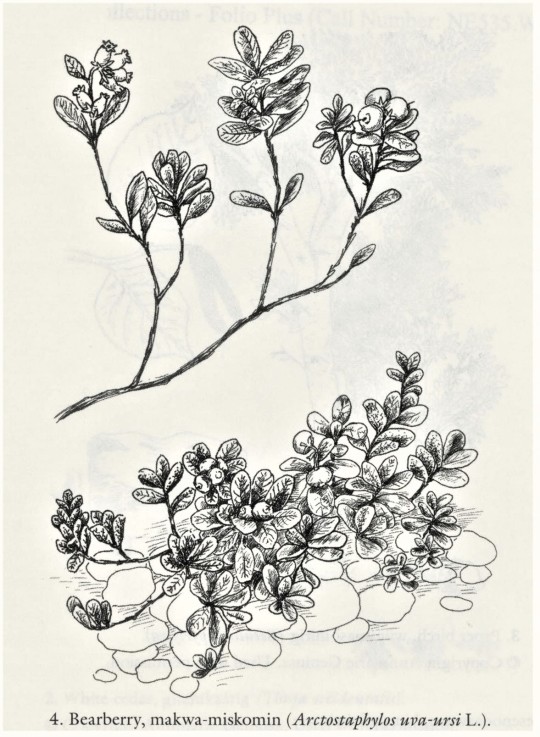


(Decolonizing) Science Saturday
This Saturday we are sharing some illustrations from our first edition copy of Wendy Makoons Geniusz’s book, Our Knowledge is Not Primitive: Decolonizing Botanical Anishinaabe Teachings. The botanical illustrations are provided by the author’s sister, Annmarie Geniusz. Published in 2009 by Syracuse University Press, the book is part of their series The Iroquois and Their Neighbors. Established by the press in 1975, the publication series’ primary scope is Haudenosaunee (Iroquois) scholarship, but it also focuses on uplifting the voice of Indigenous scholars’ work in contemplating their own culture.
As an academic raised in the Anishinaabe culture, Geniusz is particularly well suited to critically examine the Western scientific lens through which Indigenous botanical knowledge is often presented in the Academy. Genuisz, who got her undergraduate degree here at UWM, is the former director of the American Indian Studies program at University of Wisconsin-Eau Claire, and currently teaches Ojibwe language there.
View more of our Science Saturday posts here.
You can find more posts on our Native American Literature Collection here.
-Olivia, Special Collections Graduate Intern
#Science Saturday#Our Knowledge is Not Primitive#Wendy Makoons Geniusz#Wendy Geniusz#Annmarie Geniusz#Anishinaabe#Ethnobotony#Decolonization#Syracuse University Press#The Iroquois and Their Neighbors#Indigenous Scholars#Anishinaabe-gikendaasowin#Native American Literature Collection#olivia
4K notes
·
View notes
Text

I went to the local used book store today with a friend and was lucky to find a few feminist books. I've seen quotes of Naomi Wolf's The Beauty Myth and Promiscuities on tumblr before and I am looking forward to reading it. Please feel free to let me know your insights if you have read these. I'm particularly excited for the center book as I am Native American.
Obviously, it is important to be critical when reading any literature regarding Feminist theory and form your own opinions and beliefs. Only through education and learning our history of opression through the voices of the feminists before us will be also be able to make change in our time that can benefit the health and safety of all women now and in the future.
#feminist reading#feminist literature#books#reading#personal collection#Naomi Wolf#Promiscuities#Mary Daly#Pure Lust: Elemental Feminist Philosophy#Kathleen M. Donovan#Coming to Voice: Feminist readings of Native American Literature
8 notes
·
View notes
Text
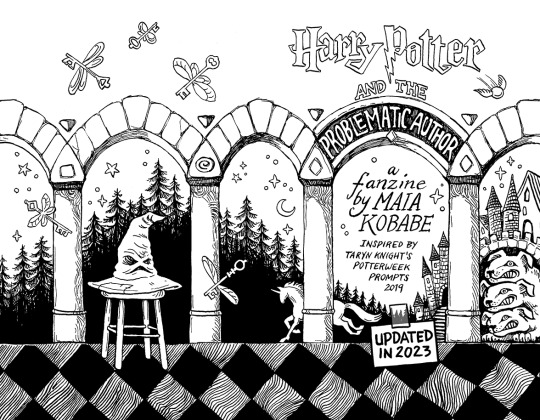
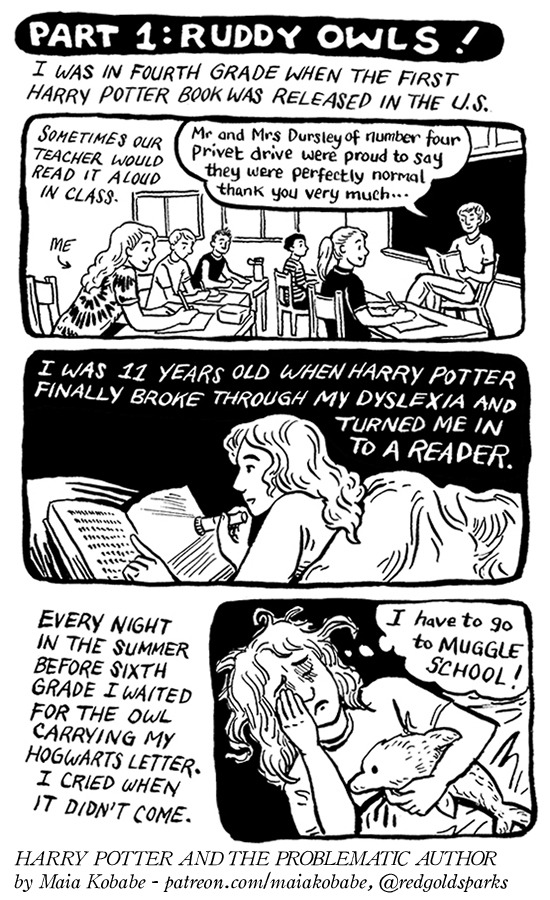


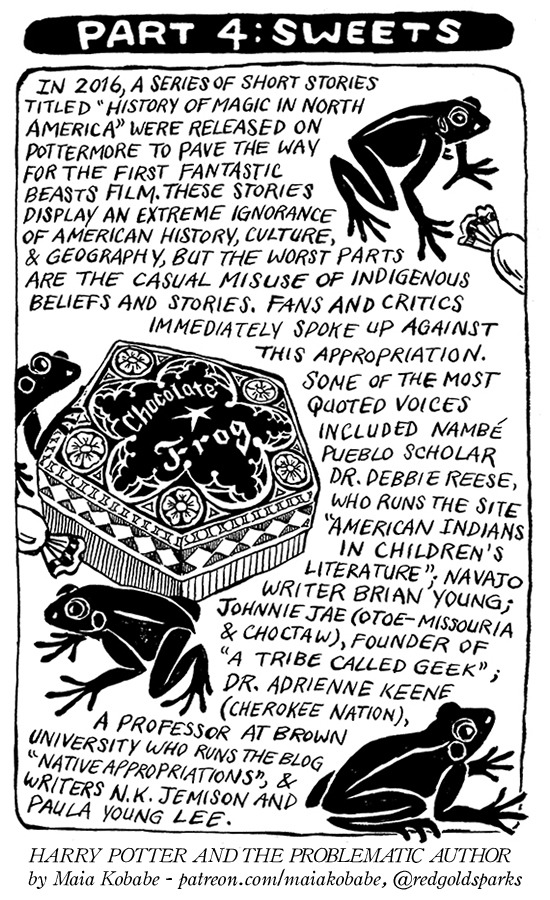


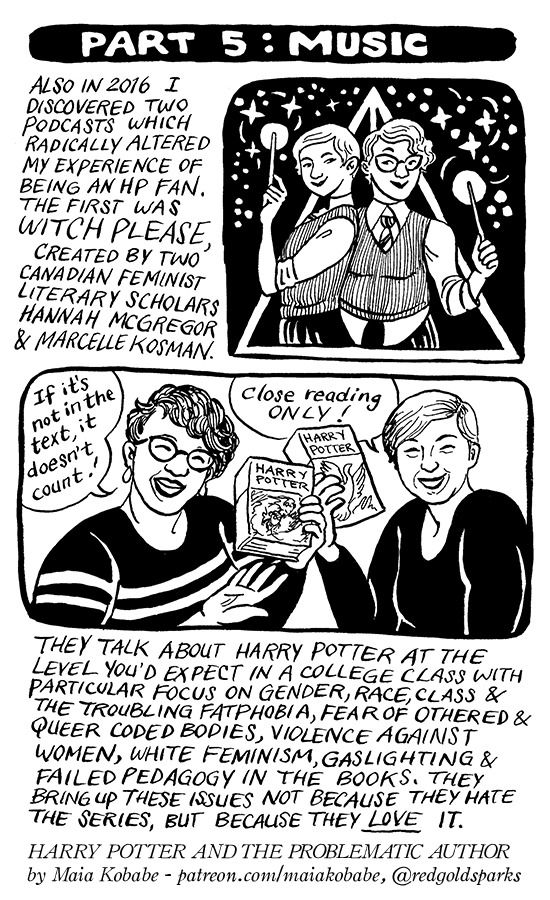

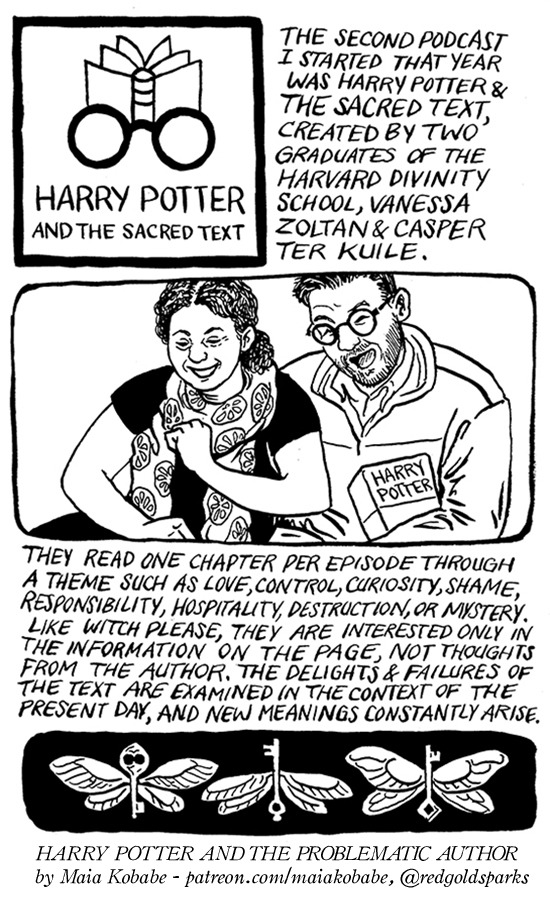
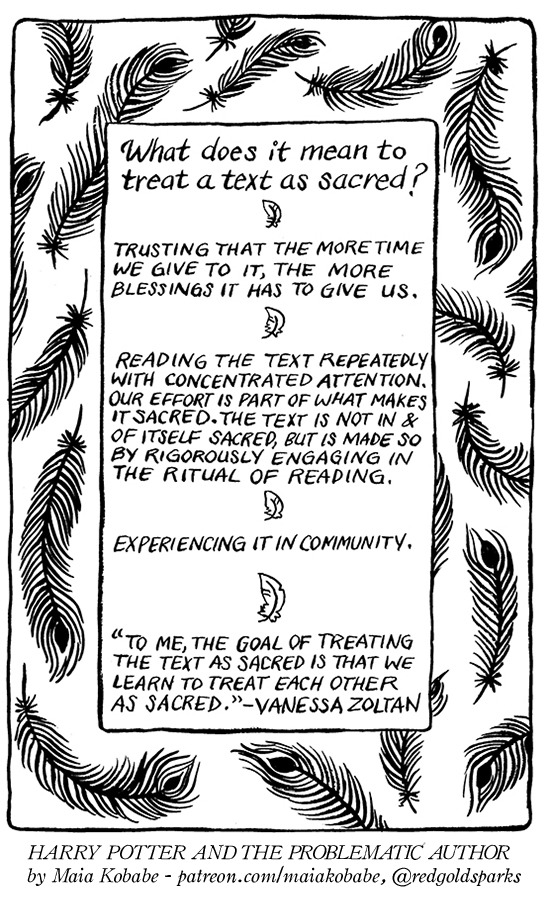


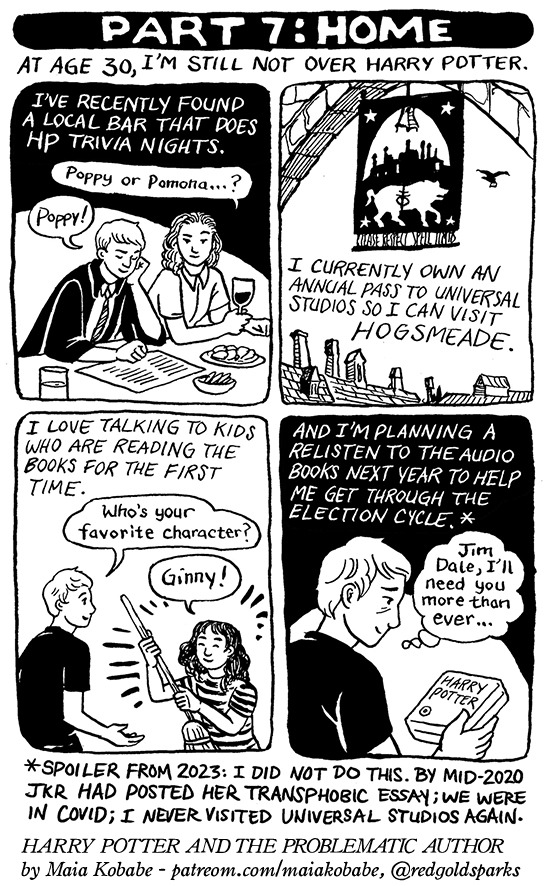

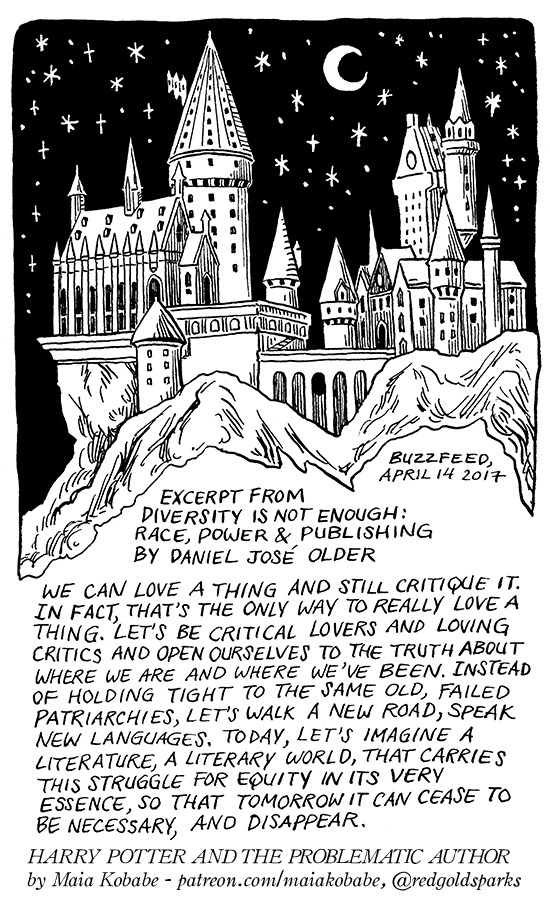
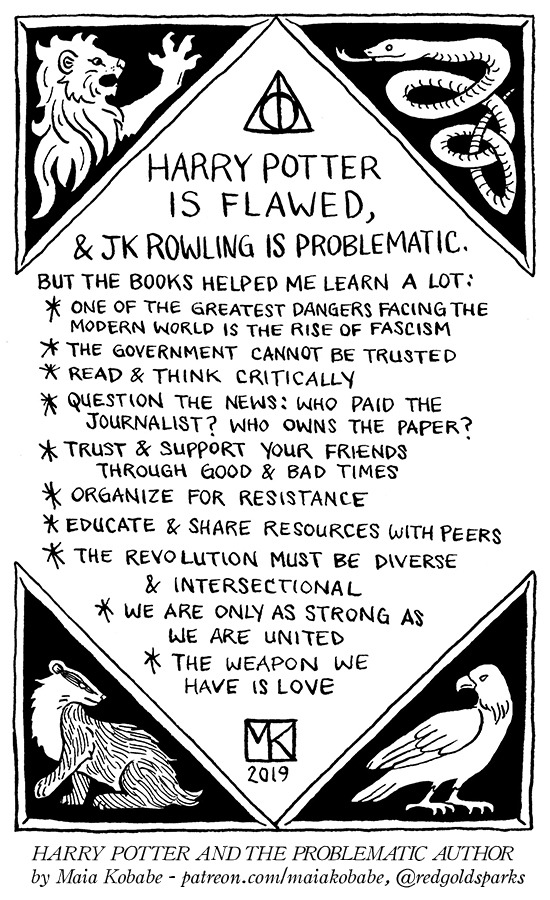

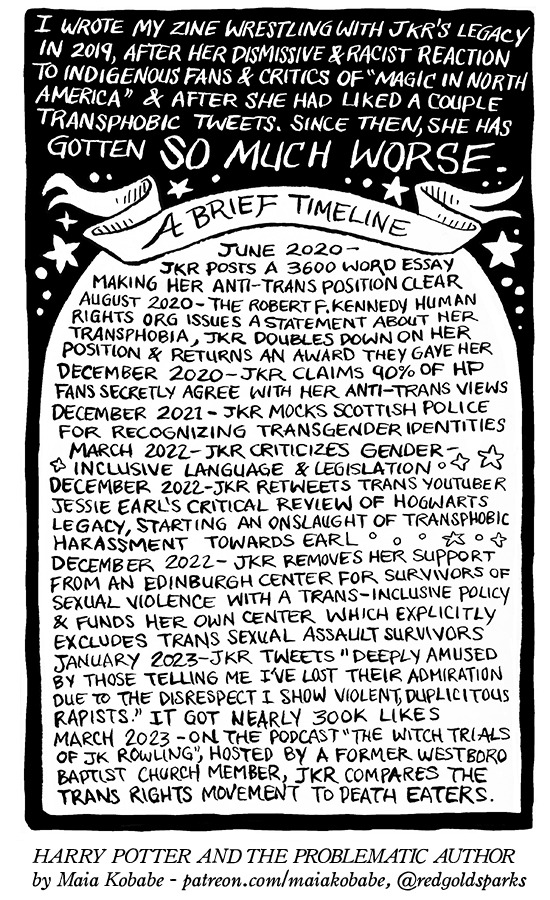


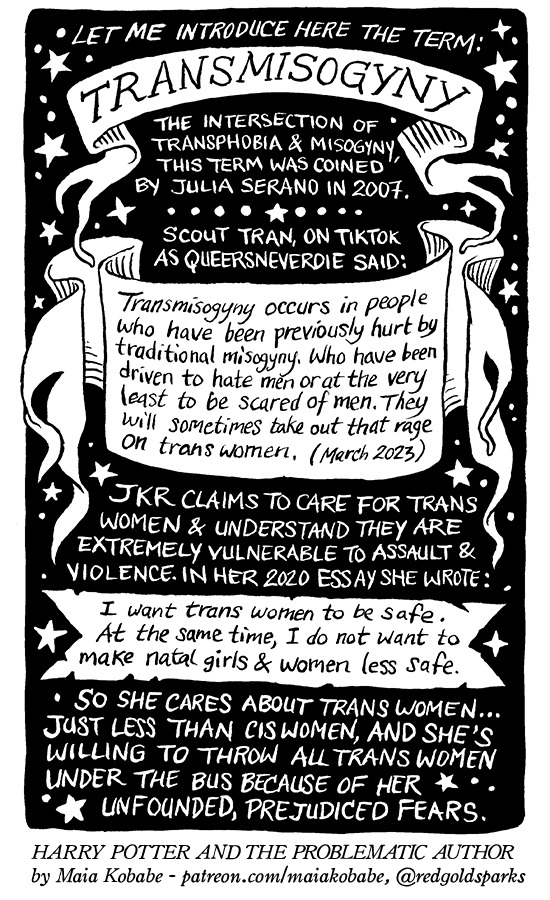
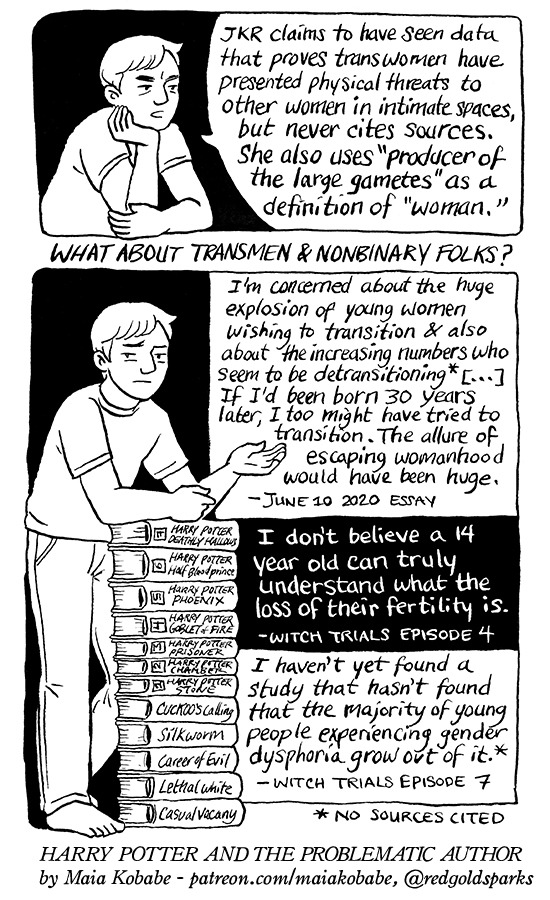



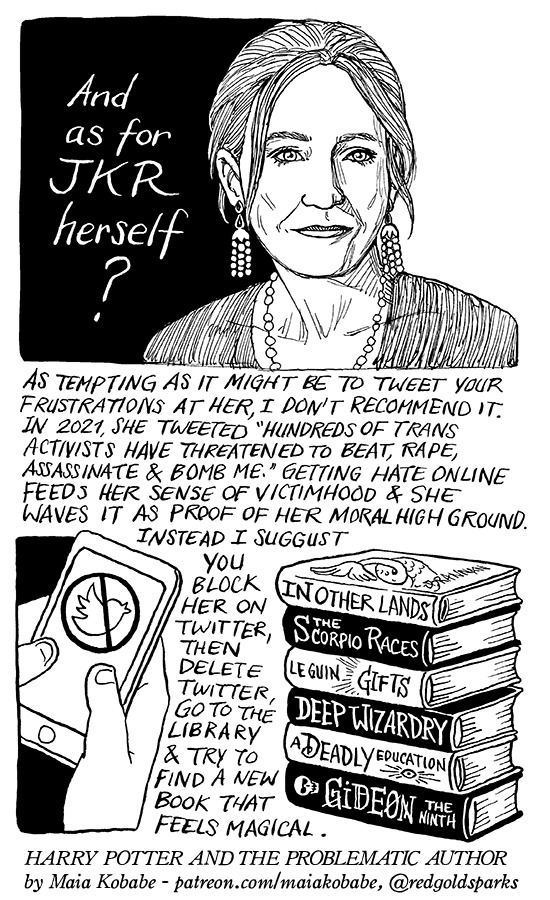
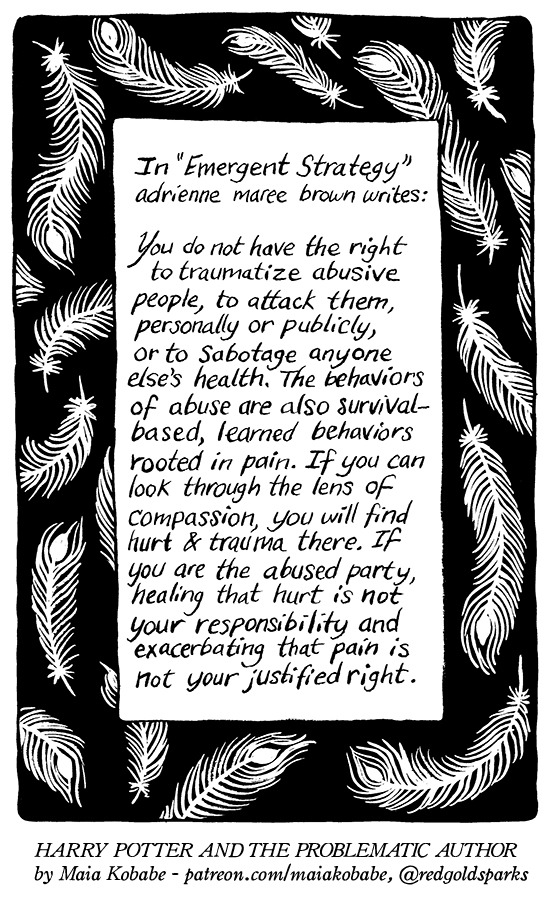
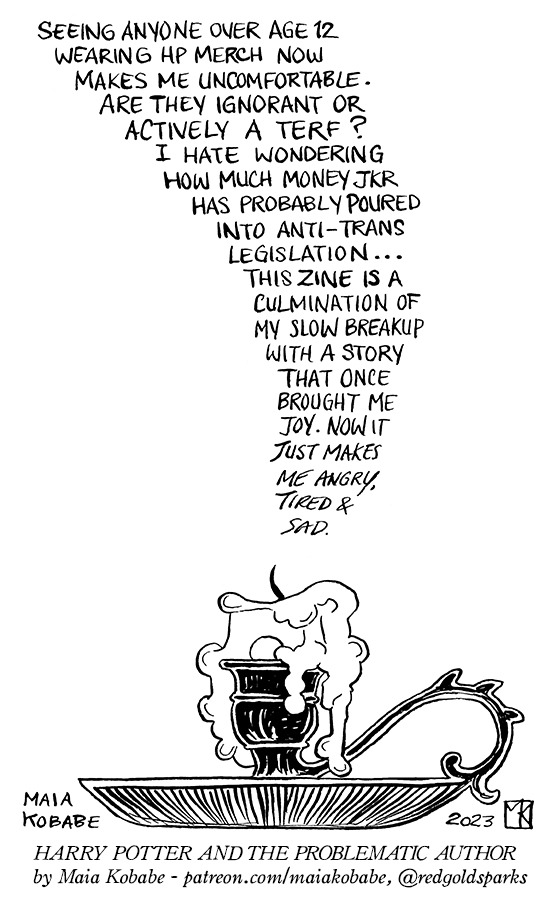
I wrote a 12 page epilogue to my 2019 comic "Harry Potter and The Problematic Author" because I found, in 2023, that I had more to say. You can also find this comic on my website, and I have PDF copies available on etsy. I may sell print copies at some point in the future.
instagram / patreon / portfolio / etsy / my book / redbubble
Full transcript below the cut.
PAGE 1
Part one: Ruddy Owls!
I was in fourth grade when the first Harry Potter Book was released in the US.
Panel 1: Sometimes our teacher would read it aloud in class. “Mr and Mrs Dursley of number 4 Privat Drive were proud to say they were perfectly normal, thank you very much…”
Panel 2: I was 11 years old when Harry Potter finally broke through my dyslexia and turned me into a reader.
Panel 3: Every night in the summer before sixth grade I waited for the owl carrying my Hogwarts Letter. I cried when it didn’t come. “I have to go to Muggle school!”
PAGE 2
Part Two: Hats
I dedicated myself to being a fan.
Panel 1: I began collecting Harry Potter News article.
Panel 2: I asked my relatives to mail me ones from their local papers. I filled a thick binder with clippings.
Panel 3: I wrote my own trivia quiz
Panel 4: and participated in the one held annually at the county fair. “Next contestant!”
Panel 5: I usually got into one of. the top five spots. I won boxes of candy, posters, stationary, and once a baseball cap. (Hat reads: I survived the battle of Hogwarts).
Panel 6: In high school I sewed a black velvet cape and knitted many stripped scarves.
PAGE 3
Part Three: Double Trouble
Watching the last film in 2011 felt like the final note of my childhood.
Panel 1: I remember driving home from the midnight showing thinking about the end of 13 years of waiting; wondering what would define the next chapter of my life.
Panel 2: That same month I heard of something called Pottermore. “Okay, so there’s a sorting quiz… I already know my house! Patronus assignment? Mine’s a barn owl. Duh!"
Panel 3: You can read the books again but with GIFs? Why?
Panel 4: I lived in a place with very slow and limited internet at the time. Pottermore sounded inaccessible, but also boring. I never joined.
Panel 5: "I’ll just read the actual books again, thanks."
PAGE 4
Part Four: Sweets
In 2016, a series of short stories titled "History of Magic in North America” were released on Pottermore to pave the way for the first Fantastic Beasts Film. These stories display an extreme ignorance of American history, culture, and geography, but the worst parts are the casual misuse of indigenous beliefs and stories. Fans and critics immediately spoke up against this appropriation. Some of the most quoted voices included Nambe Pueblo scholar Dr. Debbie Reese who runs the site “American Indians In Children’s Literature”; Navajo writer Brian Young; Johnnie Jae (Otoe-Missouria and Choctaw), founder of A Tribe Called Geek; Dr Adrienne Keene (Cherokee Nation), a Professor at Brown University who runs the blog “Native Appropriations”, and writers N.K. Jemison and Paula Young Lee.
PAGE 5
Rowling is famous for responding to fans directly on twitter, yet she did not respond to anyone calling out the damaging aspects of “Magic in North America.” Her representatives refused to comment for March 9 2016 article in the Guardian. She has never apologized. All of this, plus the casting of Johnny Depp and the specific declarations of support by JKR, Warner Brothers, and director David Yates left a sour taste in my mouth.
For further thoughts on the new films read The Crimes of Grindelwald is a Mess by Alanna Bennett for Buzzfeed News, November 16, 2018.
PAGE 6
Excerpt from Colonialism in Wizarding American: JK Rowling’s History of Magic in North America Through an Indigenous Lens by Allison Mills, MFA, MAS/MLIS (Cree and Settler French Canadian)
Although Rowling is certainly not the first white author to misstep in her treatment of Indigenous cultures, she has an unprecedented level of visibility and fame, […] One of the most glaring problems with Rowling’s story is her treatment of the many Indigenous nations in North America as one monolithic group. […It] flattens out the diversity of languages, belief systems, and cultures that exist in Indigenous communities, allowing stereotyping to persist. […] It continues a long history of colonial texts which ignore that Indigenous peoples still exist. […] In the Wizarding world, as in the real world, Indigenous histories have been over-written and our cultures erased.
from The Looking Glass: New Perspectives in Children’s Literature Volumn 19, Issue 1
PAGE 7
Part 5: Music
Panel 1: Also in 2016 I discovered two podcasts which radically altered my experience of being an HP fan. The first was Witch Please created by two Canadian feminist literary scholars Hannah McGregor and Marcelle Kosman.
Panel 2: “If it’s not in the text it doesn’t count!” “Close reading ONLY!”
Panel 3: They talk about Harry Potter at the level you’d expect in a college class with particular focus on gender, race, class, and the troubling fatphobia, fear of othered and queer coded bodies, violence against women, white feminism, gaslighting and failed pedagogy in the books. They bring up these issues not because they hate the series, but because they LOVE it.
PAGE 8
These passionate, joyful conversations went off like fireworks in my mind. I had never taken a feminist class before. I gained a whole new vocabulary to talk about the books- and the world.
PAGE 9
Panel 1: The second podcast I started that year was Harry Potter and the Sacred Text, created by two graduates of the Harvard Divinity School, Vanessa Zoltan and Casper Ter Kuile.
Panel 2: They read one chapter per episode through a theme such as love, control, curiosity, shame, responsibility, hospitality, destruction, or mystery. Like Witch Please, they are interested only in the information on the page, not thoughts from the author. The delights and failures of the text are examined in the context of the present day, and new meanings constantly arise.
PAGE 10
What does it mean to treat a text as sacred?
Trusting that the more time we give to it, the more blessings it has to give us.
Reading the text repeatedly with concentrated attention. Our effort is part of what makes it sacred. The text is not in and of itself sacred, but is made so by rigorously engaging in the ritual of reading.
Experiencing it in community.
“To me, the goal of treating the text as sacred is that we learn to treat each other as sacred.” -Vanessa Zoltan
PAGE 11
Part 6: Tooth and Claw
In October 2017, Rowling liked a tweet linking to an article arguing that trans women should be kept out of women’s bathrooms because of cisgender women’s fears. In March 2018, she liked a tweet about the problem of misogyny in the UK Labour Party which included the line “Men in dresses get brosocialist solidarity I never had.” The author of the tweet had previously posted many blatantly anti-trans statements.
Rowlings publicist claimed she had liked the posted by accident in a “clumsy and middle-aged moment.” Yet, in September 2018 she liked a link posted by Janice Turner to her column in the Times UK titled “Trans Rapists Are A Danger In Women’s Jails.”
Screencaps of these tweets can be found in the article “The Mysterious Case of JK Rowling and her Transphobic Twitter History”, January 10 2019 by Gwendolyn Smith (a trans journalist), LGBTQNation.com
PAGE 12
Excerpt from: Is JK Rowling Transphobic? A Trans Woman Investigates by Katelyn Burns
Ultimately, the answer is yes, she is transphobic […] I think it’s fair that she receives criticism from trans people, especially given her advocacy on behalf of queer people in general, but also because she has a huge platform. Many people look up to her for creating a singular piece of popular culture that holds deep meaning for fans from different walks of life, and she has a responsibility to handle that platform wisely. (Published on them.us March 28, 2018)
PAGE 13
Part 7: Home
At age 30, I’m still not over Harry Potter.
Panel 1: I’ve recently found a local bar that does HP trivia nights. “Poppy or Pomona?” “Poppy!”
Panel 2: I currently own an annual pass to Universal Studios so I can visit Hogsmeade.
Panel 3: I love talking to kids who are reading the books for the first time. “Who’s your favorite character?” “Ginny!”
Panel 4: And I’m planning a relisten to the audio books to next year to help me get through the election cycle. “Jim Dale, I’m going to need you more than ever…”
Spoiler from 2023: I did not do this. By mid-2020 JKR had posted her transphobic essay; we were in covid; I never visited Universal Studios again.
PAGE 14
But I do want to learn from her mistakes. I never want to repeat “Magic in North America.” As I write, I will do my research. I will consult experts and compensate them. If a reader from a different culture/background than me speaks up about my work, I will listen and apologize. I KNOW I WILL MAKE MISTAKES. But I will own up to them and I will do better.
PAGE 15
Excerpt from Diversity Is Not Enough: Race, Power and Publishing by Daniel José Older
We can love a thing and still critique it. In fact, that’s the only way to really love a thing. Let’s be critical lovers and loving critics and open ourselves to the truth about where we are and where we’ve been. Instead of holding tight to the same old, failed patriarchies, let’s walk a new road, speak new languages. Today, let’s imagine a literature, a literary world, that carries this struggle for equity in its very essence, so that tomorrow it can cease to be necessary, and disappear. (Buzzfeed, April 14, 2017)
PAGE 16
Harry Potter is flawed, & JK Rowling is problematic. But the books helped me learn a lot:
*One of the greatest dangers facing the modern world is the rise of fascism
*The government cannot be trusted
*Read and think critically
*Question the news: who paid the journalist? Who owns the paper?
*Trust and support your friends through good times and bad
*Organize for resistance
*Educate and share resources with peers
*The revolution must be diverse and intersectional
* We are only as strong as we are united
*The weapon we have is love
MK 2019
PAGE 17
PART 8: EPILOGUE
In 2021 I removed a Harry Potter patch I sewed to my book bag over a decade ago. I took 15 pieces of Harry Potter fanart off my walls. I got rid of my paperback book set, 2 board games, and 8 t-shirt. [images: a Hogwarts a patch with loose threads, a pair of scissors and a seam ripper]
Panel 1: Maia holding up a shirt with the Deathly Hallows logo on it. Maia thinks: “Damn, this really used to be my entire personality.”
Panel 2: The t-shirt gets thrown into the Goodwill box.
PAGE 18
I wrote my zine wrestling with JKR’s legacy in 2019, after her dismissive and racist reaction to indigenous fans and critics of “Magic in North America” and after she had liked a couple transphobic tweets. Since then, she has gotten so much worse.
A Brief Timeline (mostly from this Vox article)
June 2020- JKR posts a 3600 word essay making her anti-trans position clear
August 2020- The Robert F Kennedy Human Rights Org issues a statement about her transphobia, JKR doubles down on her position and returns an award they gave her
December 2020- JKR claims 90% of HP fans secretly agree with her anti-trans views
December 2021- JKR mocks Scottish Police for recognizing transgender identities
March 2022- JKR criticizes gender-inclusive language and legislation
December 2022- JKR retweets trans youtuber Jessie Earl’s critical review of Hogwarts Legacy, starting an onslaught of transphobic harassment towards Earl
December 2022- JKR removes her support from an Edinburgh center for survivors of sexual violence with a trans-inclusive policy and funds her own center which explicitly excludes trans sexual assault survivors
January 2023- JKR tweets “Deeply amused by those telling me I’ve lost their admiration due to disrespect I show violent, duplicitous rapists.” It got nearly 300K likes
March 2023- One the podcast “The Witch Trials of JK Rowling”, hosted by a former Westboro Baptist Church Member, JKR compares the trans rights movement to Death Eaters.
PAGE 19
What are The Witch Trials of JK Rowling?
Panel 1: Maia speaking. “It’s a 7 episode documentary style podcast hosted by Megan Phelps-Roper. Nearly every episode contains interviews with JKR as well as critics, journalists, historians, protestors and fans.
Panel 2: Maia speaking. “In episode 1, JKR speaks more candidly than she has previously about being in an abusive marriage. Her ex-husband hit her, stalked her, broke into her house overlapping with the time she was writing the first three HP books.”
Panel 3: Maia speaking. “What she went through genuinely sounds horrific. I have a lot of sympathy for the kind of life-long traumas those experiences leave.”
PAGE 20
HOWEVER.
It is clear from reading the June 2020 essay on her blog and listening to the podcast, that JKR still to this day feels unsafe. Despite her wealth and privilege she moves through the world with the mindset of a victim. And the group of people she finds most threatening are trans women.
Or rather, she is afraid that allowing trans women in women’s spaces invites the possibility of male predators entering those spaces.
Here’s a direct quote: The problem is male violence. All a predator wants is access and to open the doors of changing rooms, rape centers, domestic violence centers [...] to any male who says “I’m a woman and I have a right to be here” will constitute a risk to women and girls. - from The Witch Trials episode 4 as transcribed by therowlinglibrary.com, March 2023
Image: A stem of Belladonna with flowers and berries.
PAGE 21
Let me introduce here the term: TRANSMISOGYNY. The intersection of transphobia and misogyny, this term was coined by Julia Serano in 2007. Scout Tran, on tiktok as Queersneverdie said: “Transmisogyny occurs in people who have been previously hurt by traditional misogyny. Who have been driven to hate men or at the very least to be scared of men. They will sometimes take out that rage on trans women. (March 2023)
JKR claims to care for trans women and understand they are extremely vulnerable to assault and violence. In her 2020 Essay she wrote: “I want trans women to be safe. At the same time, I do not want to make natal girls and women less safe.”
So she cares about trans women… just less than cis women, and she’s willing to throw all trans women under the bus because of her unfounded, prejudice fears.
PAGE 22
Panel 1: Maia speaking. “JKR claims to have seen data that proves trans women have presented physical threats to other women in intimate spaces, but never cites sources. She also uses “producer of the large gametes” as a definition of “woman”.
What about transmen and nonbinary folks?
Panel 2: Maia leaning on a stack of all seven HP books, the first four Cormorant Strike books and The Casual Vacancy, gesturing to a series of quotes with a tired and disgusted expression.
I’m concerned about the huge explosion of young women wishing to transition and also about the increasing numbers who seem to be detransitioning. * [...] If I’d been born 30 years later, I too might have tried to transition. The allure of escaping womanhood would have been huge. -June 10 2020 essay
I don’t believe a 14 year old can truly understand what the loss of their fertility is.
-Witch Trials episode 4
I haven’t yet found a study that hasn’t found that the majority of young people experiencing gender dysphoria grow out of it*. -Witch Trials episode 7
*No sources cited
PAGE 23
It’s hard to over emphasize how fixated JKR has become on these topics. As of the date I’m writing this, 14 out of her 20 most recent tweets (70%) are in some way anti-trans. She tweets against Mermaids (a UK based trans youth charity), against trans athletes, against gender neutral bathrooms, and in support of LBG Alliance- a UK org that denies trans rights while upholding gay rights. Here are some gems from her archive:
“People who menstruate.” I’m sure there used to be a word for those people. Someone help me out. Wumben? Wimpund? Woomud? -June 2020
War is Peace. Freedom is Slavery. Ignorance is Strength. The Penised Individual Who Raped You Is a Woman. - December 2021
And in response to someone asking “How do you sleep at night knowing you lost a whole audience?”
I read my most recent royalty cheques and find the pain goes away pretty quickly. -October 2022
PAGE 24
Hashtag Ruthless Productions a queer nerd podcast company created a great guide on ethical engagement with HP. Image: the two hosts of Hashtag Ruthless productions, Jessie (They/she) and Lark (he/him).
Stop buying all official HP Products: books, movies, games, toys, etc, Universal Studios tickets, food, merch.* Boycott any new TV series or movies. Instead: buy the books and DVDs used. If you still want to wear HP merch, buy fan-made. Engage only with fan content: fic, podcasts, fanart, wizard rock, etc. Show transphobia is bad for business. None of this will change JKR’s mind. But the Fantastic Beast series was canceled and after record Pottermore sales in 2020, they fell in 2022 by 40%.
*She gets a portion of ALL tickets. In 2019, this was her largest income source. Read the full guide: hashtagruthless.com/resourceguide
PAGE 25
As late as 2019, I was still reading JKR’s murder mystery series. But by the fourth book my experience began to sour.
Panel 1: Maia holding a copy of Lethal White. “The only gay character in this book is a government official who gropes his staff?”
Panel 2: “The only genderqueer character is misgendered and portrayed as a whiny faker?”
Panel 3: “The only Muslim character is disowned by his family over gay rumors?”
Panel 4: “Even the women aren’t portrayed very well…”
Panel 5: “Why is the main female character defined by the rape in her past?”
Panel 6: “Wait, what happens in the rest of this series…?” Maia scrolls on eir phone.
Panel 7: “Is the series heading towards an employee/boss relationship?”
Panel 8: “And has a man wearing women’s clothes to commit assault?”
Panel 9: “Yeah, I’m done. I’m never reading a new JKR book ever again.”
PAGE 26
And as for JKR herself?
As tempting as it might be to tweet your frustrations at her, I don’t recommend it. In 2021, she tweeted, “Hundreds of trans activists have threatened to beat, rape, assassinate and bomb me.” Getting hate online feeds her sense of victimhood and she waves it as proof of her moral high ground. Instead I suggest you block her on twitter, then delete twitter, go to the library and try to find a new book that feels magical.
Stack of books: In Other Lands by Sarah Rees Brennan, The Scorpio Races by Maggie Stiefvater, Gifts by Ursula K Le Guin, Deep Wizardry by Diane Duane, A Deadly Education by Naomi Novik and Gideon the Ninth by Tamsin Muir.
PAGE 27
In “Emergent Strategy” adrienne maree brown writes: You do not have the right to traumatize abusive people, to attack them, personally or publicly, or to sabotage anyone else’s health. The behaviors of abuse are also survival-based, learned behaviors rooted in pain. If you can look through the lens of compassion, you will find hurt and trauma there. If you are the abused party, healing that hurt is not your responsibility and exacerbating that pain is not your justified right.
PAGE 28
Seeing anyone over age 12 wearing HP merch now makes me uncomfortable. Are they ignorant or actively a TERF? I hate wondering how much money JKR has probably poured into anti-trans legislation… This zine is a culmination of my slow breakup with a story that once brought me joy. Now it just makes me angry, tired and sad.
Image: Candle in a fancy holder burned down to less than an inch.
Maia Kobabe, 2023
3K notes
·
View notes
Text
…This is BEYOND infuriating.
Tl;dr: Scholastic offers to license an AANHPI* author’s book as part of a collection “Amplifying AANHPI Narratives”… but only if she removes the word “racism” from the foreword of a book describing it, or else they won’t pick the book up.
…Scholastic is very much the 900-pound gorilla in the YA-literature room, and Maggie Tokuda-Hall—having politely but forcefully declined (her letter to Scholastic is in her blog post)—is understandably terrified about what may now happen to her career. But I’ll tell you, this situation leaves me intent on running straight out and buying her book. And I very much hope this ugly stance blows up, big, in Scholastic’s corporate face.
*Asian American and Native Hawaiian/Pacific Islander
1K notes
·
View notes
Text

i recently solved a fun little bug mystery at work and i thought it might be interesting to write up a step-by-step narrative of how i did so, as a sort of example of the kinds of things i get to do for my job. this is a stupidly long post because i have no editorial self-control so i'm putting the rest under a cut.
the above insect is a bark beetle, one of a series of 6 specimens i found in a drawer at work. they did not have species labels on them, and the collection labels indicated that they were collected in 1997 from "Chinese Cedrus used for artifical christmas trees." the infested wood had been intercepted and the beetles collected and pinned, but whoever was working in the lab at the time wasn't able to suss out the species, which is extremely reasonable because even IDing american bark beetles to species can be a massive pain in the ass, let alone ones from asia.
the beetles were clearly in the genus Phloeosinus based on the shape of the antennae and the large spines on the elytral declivity (the ass area), and whoever pinned them at least got them that far themselves, but determining the actual species was going to be a lot harder. even american beetles in this genus can be devilishly hard to confidently ID to species since they often look alike and also are quite morphologically variable in ways the bleed into each other. they are pretty cool though and those ass spines are usually critical in species-level identification
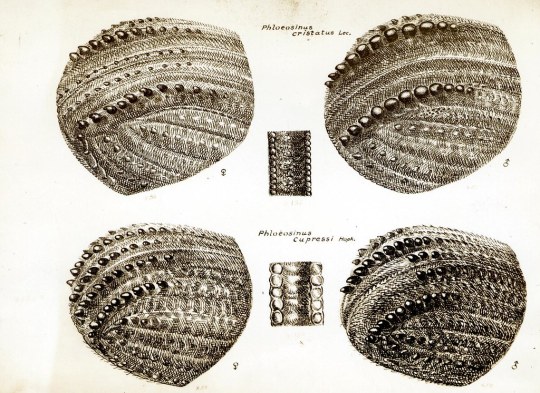
btw since i'm going to be writing out this word a lot in this post, it's pronounced roughly as "flea-o-sign-us" if you're curious.
determining bark beetle species is often made much easier by knowing what tree the beetle came out of since most bark beetles (but not ambrosia beetles, which are also scolytid/scolytine beetles but a whole other can of worms grubs) are highly host-specific, usually being adapted to only a certain tree species or genus or small group of related genera.
so Cedrus is the genus for eurasian cedar trees, and there is one species of Cedrus native to china, Cedrus deodara, but that seems like an odd choice of plant to harvest and send to america for artificial christmas tree trunks. most actual Cedrus species are from the mediterranean area. however there are also some chinese trees in the cypress family Cupressaceae (+Taxodiaceae) that are called cedars, and in fact most species of Phloeosinus are exclusively found in trees in this family. one likely species is Cunninghamia lanceolata, traditionally called "chinese fir" despite not being a fir but also more recently marketed as "chinese cedar" because that's how common names for species go.
oh and there is also the tree Toona sinensis in the family Meliaceae that's ALSO sometimes called "chinese cedar" for some reason but more importantly also called "beef and onion plant" lmao, but that was an even worse candidate for an artificial christmas tree trunk and also not a known host for the beetles. easily discounted but i had a laugh.
so my first angle of attack was to assume that the collection labels were correct and the beetles were in fact from a Cedrus tree. i was able to find a list of about a half dozen Phloeosinus species known to attack Cedrus cedars, but none of them were native to china. this would most likely mean that one of the mediterranean species had been transplanted to china for cultivation, which is entirely plausible. after digging though a bunch of literature i wasn't able to find a good key for Phloeosinus species in the entire area i wanted, but found a couple regional keys covering geographic ranges that when combined covered about what i wanted. for non-biologists, this is what a species key looks like:

sort of a choose your own adventure kind of thing but for determining a creature's true identity. anyway none of the results i got from these keys led to species who's descriptions matched the one that i had. i should also mention that my specimens had a rather distinctive feature unlike any other Phloeosinus species i'd ever seen before, which was an elytral vestiture consisting of these really funky little black explanate scales:
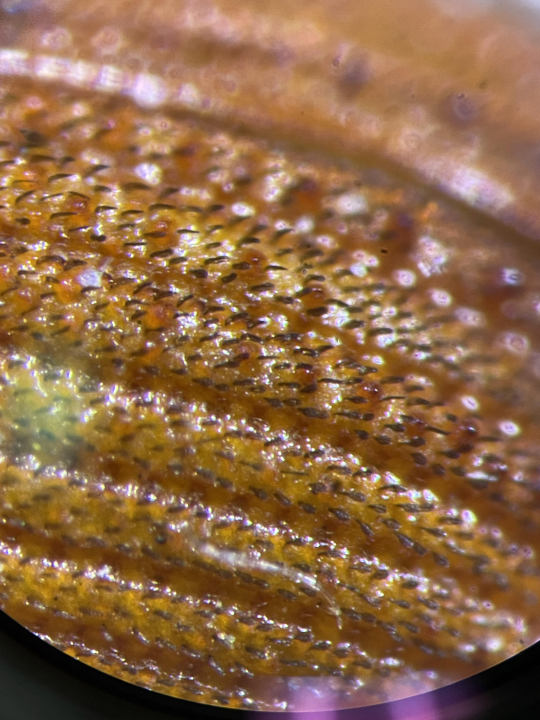
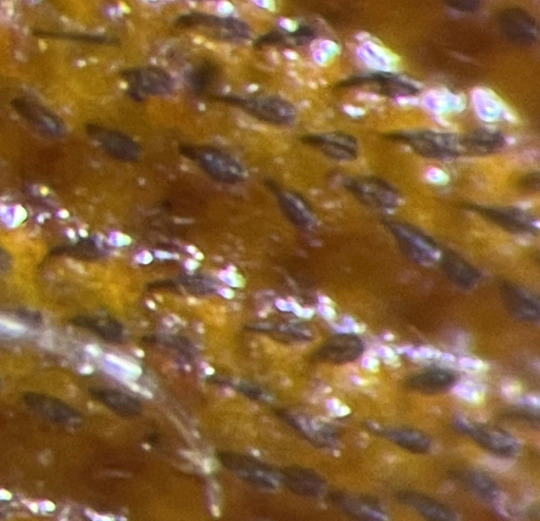
most Phloeosinus species have some kind of vestiture on their elytra but all the ones i'm familiar with have the hairs and scales light-colored and never shaped anything like this, so i figured that the description of the correct species would surely mention these scales.
so anyway dissatisfied with this avenue, i decided that the next most likely option is that whoever made the labels for the specimens was told that they had come from "chinese cedar" by the importer and had just assumed that meant Cedrus but it was actually one of the cypress family cedars. again most of the described species do in fact use Cupressaceae as hosts.
so next i found this UN report with a (hopefully) comprehensive list of all non-EU bark and ambrosia beetle species that attacked conifer trees. i culled from that a list of Phloeosinus species listed as coming from "asia." since that was too broad of an area, i then looked up all of these species in the species catalogues listed in the report, mostly Alonso-Zarazag et al (2007), though some were also listed in Wood and Bright (1992) or Bright and Skidmore (2002), which i happen to have physical copes of. from these i could narrow the list down to just species found in china.
now things became difficult because there are no keys to chinese Phloeosinus, or at least none in english. also even just written descriptions of many of these species were impossible to find because they were all written like 60-100 years ago and usually in chinese or german or french and had never been translated or uploaded anywhere online. likewise almost none of them had research-grade (or any) photos anywhere online.
so after hours of fruitless digging, the best i could come up with was a guide to scolytine beetles of korea (PDF link), which contained a key with a handful of the species on my list and did include english descriptions of these. now one of the species in the guide, P. perlatus, IS DESCRIBED as having dark scales, and my specimens did seem to land on that species when i ran them through the key. that's promising! and the hosts were on my list of possible non-Cedrus chinese cedars! also promising! buuuut something just didn't sit right with me. parts of the species description in that paper just didn't seem to quite match my specimens, like for example the size was a little off, described as being 2.4-3.4mm long, while all of mine were in the 3.3-3.6 range. plus the photos of the species, while distressingly low-resolution, just didn't look like mine.
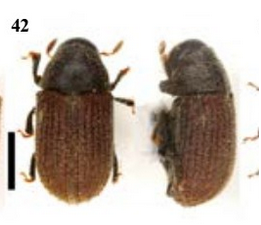
okay so that was dissatisfying. i'd managed to whittle down my list of suspects a good deal from what little scraps of information i could find about them through my sleuthing, either the wrong hosts or the ones that did have english descriptions available online like in that korean guide didn't fit, but i was still left with several possible candidates and no way to narrow it down further, of course this all assuming that the beetles i had on my hands even were a species that had been scientifically described and named. bark beetles are a huge group of critters and many are quite understudied, especially in asia, and a bunch of new species are described every year!
i was about ready to just give up, but then by coincidence i had a reason to email a couple of high-level bark beetle researchers about a different beetle mystery i was also working on, which was in a group that they were the authorities on. on a whim, i mentioned my Phloeosinus conundrum to them to see if they had any ideas and they recommended i contact Dr. Roger Beaver. yeah, i know right? fucking kickass name i'm so jealous. sidenote: it's so funny how many bark beetle researchers have extremely appropriate names, like two of the biggest names in the field are Steve Wood and Dave Wood. no relation.
so anyway i contacted Dr Beaver, who had done some research on east asian Phloeosinus in the past and he was kind enough to send me an unpublished provisional key to chinese species that he had written up a few years ago. using that key, i ended up at "P. pertuberculatus (?=sinensis)" which means that there was some suspicion that P. pertuberculatus and P. sinensis were the same species, just described and named independently by two different entomologists (Hans Eggers and Karl Eduard Schedl respectively), as often happened, especially in the glory days of insane 18th-20th century european entomologists describing literally thousands of new species during their careers.
now these two species WERE both on my final list of suspects of chinese Phloeosinus species that hadn't otherwise been eliminated for one reason or another, and both had Cunninghamia "cedar" trees as known hosts. Dr Beaver was then kind enough to scan and send me the original descriptions of these two species:
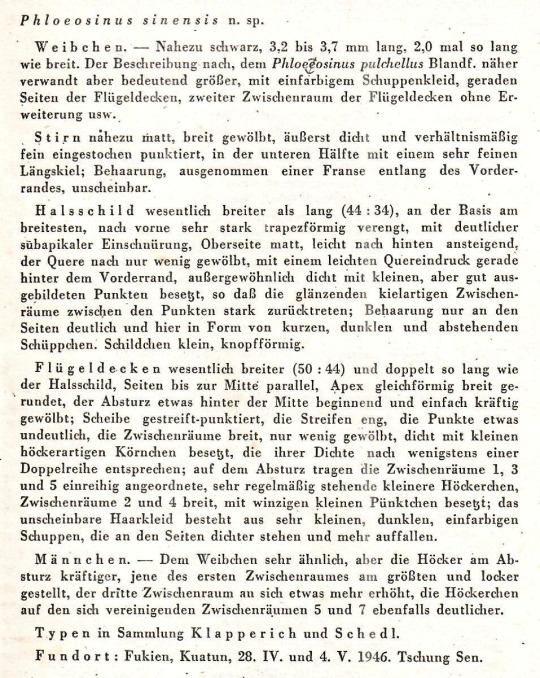
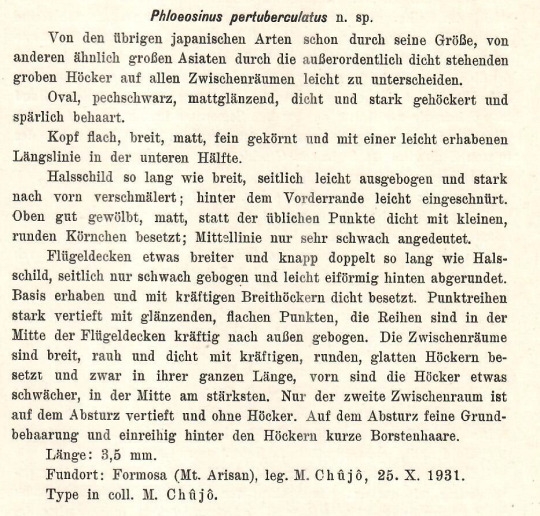
which i was able to use google translate on:
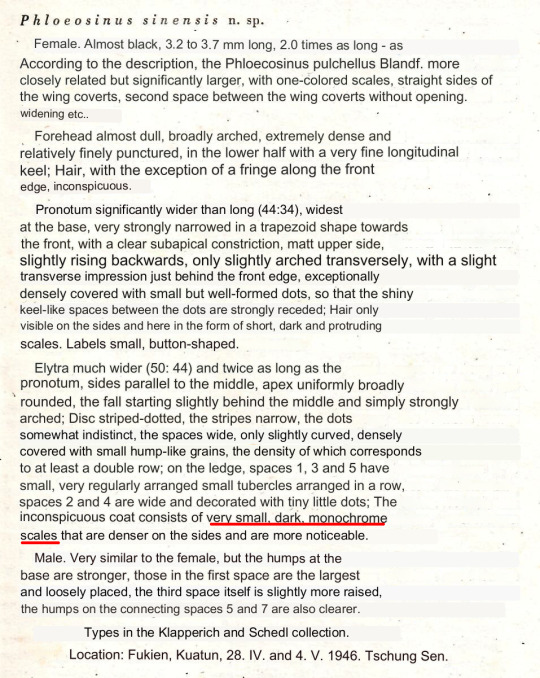
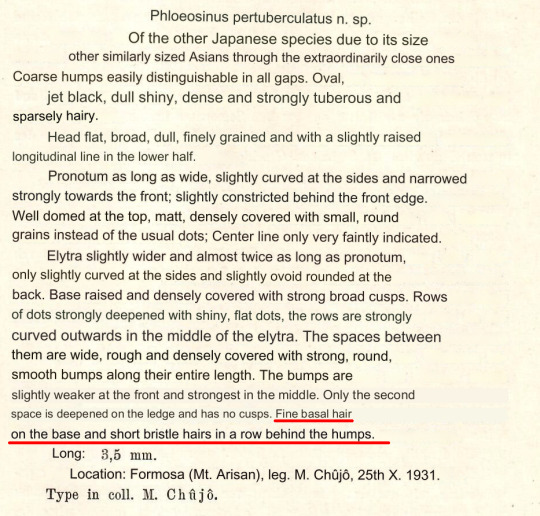
not the nicest translation but still an admirable attempt on google's part to deal with all the entomological jargon, and most importantly the description of the elytral scales on P. sinensis definitely seems to match my specimens more than the pertuberculatus. plus i found a paper on taiwanese bark beetles (PDF) coauthored by Dr Beaver that had a (also distressingly low-resolution) photo of pertuberculatus that didn't seem to match my specimens:

aaand finally: i'd been trying for days to access the webpage of a chinese museum that popped up as the only notable result on a google image search for P. sinensis but every time the website would time out and the cached version of the image was too small to make out any details on, but it finally occurred to me this evening that the reason was probably because my work computer or work wifi was just automatically blocking chinese websites because of america's insane paranoia about chinese spying, and sure enough i opened it up on my home computer and it fucking worked!

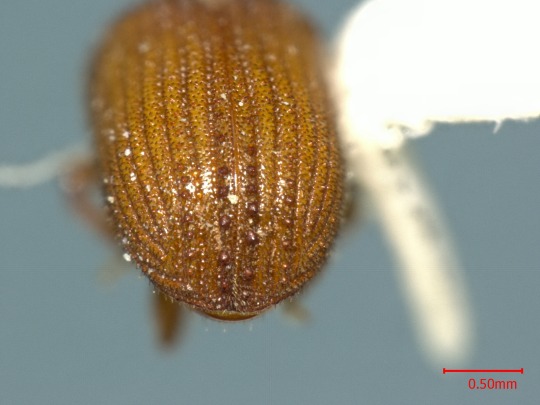

that's a pretty fucking bang-on match for my specimens! the scales look right, the color is right, the size is right, the ass bumps are right, the host is right, the geography is right, and the translated description otherwise seems to match! here's mine again so you don't have to scroll all the way up:

so i'm calling this 26-year mystery solved! not all of the bug puzzles i've worked on have had as meandering of a path to their conclusion as this, but i thought that this one did display a good number of the different methods i use. the biggest thing that was missing was me wandering into my lab's massive library of old dusty entomology journals stretching back over a century and digging out some old article that never got scanned and put online, as often happens, but in this case since the bugs were asian and out library mostly covers north american entomology that wasn't going to be very fruitful.
hopefully this was interesting to... somebody besides myself. if you've read this far and weren't bored to tears then congratulations you probably have the same kind of brain damage as me!

299 notes
·
View notes
Text
Human Alastor Reference Guide.
Part 1: Essentials.
Mainlist and background information.
Drawing Biracial Characters
A Brief Guide on Designing Biracial Characters.
Portraying Mixed Ppl.
"The Louisiana Creole community are people of mixed French, African, Spanish, and Native American ancestry. An extraordinary Creole culture rich in traditions around food, literature, music, and more thrives in New Orleans." - Trinity Acklin.
A small photo collection of Louisiana Creole people.
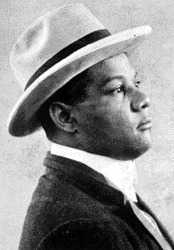

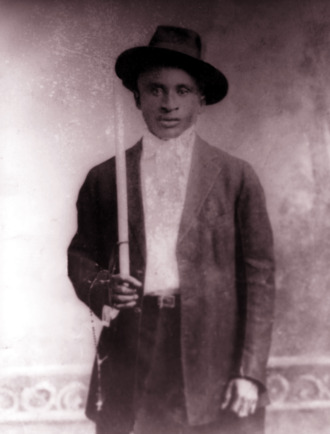




A website dedicated to information about Creole people. (Note the website has not been updated for several years.) Also, A list of Notable Louisiana Creole People.
Color guides to skin tones.

Source and more detail about painting skin tones.

Little height guide Because he's 7ft tall in the show.

Bonus!
'A Chosen Exile': Black People Passing in White America.
Character design references visual library.
13 notes
·
View notes
Text
2022 Reading Challenge For People Who Want Something Simple
Thank you for putting together this challenge, @godzilla-reads! These prompts were fun.
This reading challenge is now complete!
January - A Book UNDER 300 Pages: Subtle Blood by K.J. Charles
February - Read a Book by a Female Author: The Soulmate Equation by Christina Lauren
March - Read a Piece of Classic Children’s Literature: The Voyage of the Dawn Treader by C.S. Lewis
April - A Book with a BLUE Cover: The Feather Thief by Kirk Wallace Johnson
May - Read a Short Story/Essay Collection: Goodbye, Again by Jonny Sun
June - Choose a Light Fantasy Novel: Unusual Chickens for the Exceptional Poultry Farmer by Kelly Jones
July - Reread a Favorite of Your Choosing: Red, White, & Royal Blue by Casey McQuiston
August - A Book with an Animal being the Main Character: Cornbread & Poppy by Matthew Cordell
September - Choose a Classic Literature Book (or a book more than 50 years old): The Wolves of Willoughby Chase by Joan Aiken
October - Halloween/Samhain Book!! or Spoooooooky Poetry: What the Hex by Alexis Daria
November - Choose a Book to Read by a Native American Author: Fry Bread by Kevin Noble Maillard
December - A Book with a RED Cover: Two Wrongs Make a Right by Chloe Liese
131 notes
·
View notes
Text
second languages ~ trystan thorne (crimes of passion)
> part 2

series summary: How Trystan forgets his mother tongue - the trials and tribulations, the consequences and the guilt that follows and how he struggles to learn it back again.
chapter 2: "I will not ask you where you came from"
chapter summary: trystan says he cares, but who is willing to take them seriously?
wc: 2.2k | teen and up for strong language
read it on ao3 here
title from 'like real people do' by hozier
Trystan woke up, cold sweat running down the back of his neck. It was four in the morning. His translator, Leon, slept soundly next to him.
He wrote a note for him and stuck it to his fridge, before taking a leave. Leon worked with him for a speech he delivered at the Drakovian Embassy for the unveiling of the newly established library, housing an extensive collection of literature from his home. Everyone, however, was more puzzled by the fact Trystan had a Drakovian-language translator and chose to speak in English instead. A personal choice, some had excused him. The wound from his exile two years ago had left a scar across his tongue. The people at the embassy were defensive, knowing it wasn’t wise to question his decision since he bore a surname that struck fear into their spines.
Leon was appointed because he was an intern. Disposable. He could understand English, but only be able to speak Drakovian and some Croatian thanks to some of its similarities. Leon was an anomaly, he believed. Neither here, nor there. Half American on his mother’s side and half Drakovian on his father’s.
It was his first speech translator job and first time speaking next to a podium because that was all he could dream of. He used his economics degree in the morning while learning a third language at night. He’d admitted how difficult it was for him and the pure joy that came from understanding two sentences, hoping to get to three sentences one day. People like him were well-versed with how different words communicated different ideas. It didn’t occur to Trystan until Leon gave him a warning.
“The unveiling of the new library will let our culture and literature reach more people without any barriers.” he’d said.
Leon translated it into a worrying, “The unveiling of the library will let people use our culture and literature with no restrictions.”
Listening to someone speak his native language was like a lifeless heart being carefully brought back to life in a surgery; being nurtured into remembering its old functions. Trystan missed it; fully anticipating he would die on the operating table so much, the actual solution didn’t give him any sense of optimism.
He wrote a note to Leon. Trystan said he was sorry he had to leave early. He added he had a good time and offered him hope of maybe doing something like this later.
It was oddly cruel given that Leon processed English completely differently. He would read a sentence, translate its meaning - the crux of it into his native language and try his best to explain it the same to himself. Trystan's note would give him the wrong impression because offering someone the optimism of a second time in the bluntest possible manner would squander any such hope. That and Trystan didn't provide him any helpful information.
English was blunt in a way that it required too many words to make a point.
Trystan's note on the Post-It read: Thanks. Sorry, I have to go. Hope we can talk soon - Trystan.
It didn't matter how genuine Trystan made it sound like, Leon would never quite register it the same way. Language barriers. One born and brought up on the bridge between two languages would clearly be able to distinguish the dissimilarities and unite the commonalities. One born and brought up on one end, only to cross over to the other and burn the bridge entirely would have a very narrow field of view. That is, until the fire and smoke cleared out.
Trystan didn't have a means of transport to get home. He decided to walk for a bit, with his Maps on. He passed by some early-risers, joggers and a couple of 24 hour shops. The street was empty but well-lit. Few sparse cars went around the perimeter all night long. He kept a lookout for yellow taxis, double and triple checking his wallet. He should be okay. He'd grabbed one of Leon's baseball caps, figuring he wouldn't miss it and tied his scarf tightly around his face and neck. A precaution. Mags would be livid at his behaviour. She'd been quite overprotective, almost taking all the blame for the words he'd said and the things he'd done.
Mostly the words.
Trystan had quickly learned in his two years that the American tabloids cared too much about his words. Opinions took the front page, with an exhausting amount spent clipping the context off of the quotations. Trystan had also quickly learned that he was to his native language as an editor was to their carefully doctored-up tabloid write up. He couldn't fully grasp the English language as well as Mags did; it seemed as though it differed entirely from place to place. At the same time, he'd lost touch with his native tongue. He'd purposefully ensured it. He was in an awful grey area where a language was only as good as its translation. That it had to draw out its own blood to be fed in with something else's sustenance.
Trystan spotted a newspaper stand near the window of a shop. He picked it up and flipped it to the International News section.
Something about a groundbreaking heart transplant in Korea, football games in Europe, so on and so forth - nothing about his home. It was odd. They usually made it at least once on the paper every Monday. One could suggest Trystan look up actual Drakovian newspapers, but what was the point in trying to show concern for his homeland when he could barely understand their language anymore? He'd assumed they'd print his library inauguration but it didn't even get a passable mention. However, Trystan knew it would be on every newspaper, every magazine and every television channel back at home. He couldn't bring himself to read it. It had the genuinity of a half-hearted nurse at a maternity ward. You couldn't do that with the lofty responsibility of bringing a new life into the world.
Finally he found a taxi. He made Trystan feel comfortable by addressing him as a friend. A couple of introductions. Hello. Hello. Long day? Certainly. I hope you aren't drunk, my friend; you're cleaning if you vomit. I won't, just a late night out.
Then there was silence in the sense the driver chatted away and Trystan listened. The driver questioned whether he spoke in a formal, artificial tone because he came from FIDI or the reason why he lived there was that he could speak in a formal, artificial voice. Trystan was certain the driver wasn't sober to begin with, steered the conversation away to how he had a friend and was showing them around Manhattan. Drivers got very chatty about the roads they'd travelled, but unfortunately he was an outlier. Jake was more keen on talking about where he grew up.
Streetspeak was quite popular in cities back home. Things moved a lot quicker compared to other provinces. Phrases such as “as fast as the next generation is born” (to say something is extremely slow) and “the sooner it takes for you to find your family, the better” (to say something is impossibly slow, it ceases to exist) were not uncommon. Same with “you speak like you're from the south of the city” (the south of Drakkos was home to many foreign embassies and neighbourhoods who usually took longer to make a point and usually talked your ear off). It wasn't too far off from the things he heard in New York.
“Do you miss it?”
“Nah.” Jake answered. “I come from around here, y'know? You're just - sick of it, you don't miss it.”
Trystan had half a mind to ask him if he was from the south of the city. “What do you miss then?”
“I'd think -- the people. Hated all of them, but - I grew up in a good neighbourhood. The people make up the whole - thing, yeah? At the end of the day, you hate them, but if not them, then who? They get you, they know what you speak - right? And they say no, because they are little shits and also because it's like uh - an affirmation. They understand you, but don't want to do anything about it. You've ever seen - y'know, strangers tell you no?”
“Usually they say fuck you before they say no or yes.”
Jake erupted into laughter. “The - uh - fuck you is embedded in that no, y'know? Encrusted into it like a sandwich. Your people wouldn't have to bother with fuck you, because - you know, they get you. Right? You get me?”
Trystan hummed in agreement. “It is really intimate when someone punches you in the eye.”
“Nah, you're not getting it. It isn't -- pain from pleasu- no pleasure from pain, yeah, it isn't that, you just - you don't have a lot of people to hate for a good reason. I hate my folks because they're the only ones who get me at the end. I hate them so fucking much I'd talk about - y'know all the kid stories I can think of and I - I don't know why I do that. And it's funny, cuz - you're just attracted to the same kind of people even though you know that you hate them.”
Trystan wanted to call bullshit. Luckily Jake anticipated that from a mile away.
“Think about it like this. Would you punch me or your mother?”
“My mother's dead.”
“All right, we'll assume she's alive. Me or your mom? Got to pick one.”
“You. I mean - it's my mom-”
“I don't punch back. Your mom's punching you back. Who are you picking? She's calling you a bunch of different names. Y'know, stuff that hurts - cuts through you like a razor blade. Do you punch her and shut her up?”
“I don't think I would.”
“See - man, that's exactly what I'm trying to say. Your mother could call you a million things and you'd still go back to her. Not because she's your mother but because you've got this -- unique weakness for her words. If she isn't going to call you a fucking idiot and get away with it, who will? It's -- like a thing I read in a paper somewhere. The words stick even if the people don't. Now you get why I talk about it?”
The taxi stopped in front of their apartment. Trystan got out, paid some wads of cash and thanked the driver for the conversation, even though he fully couldn’t understand it.
It’s the stuff of dreams, right? Get to a different city, wipe your tongue out and start a new life. All temporary stuff, of course, so you can’t get tied down and have a therapist tell you to “commit” to something. Start an arts and crafts project. Write books about your struggle when you willfully succumbed to it instead. Cut your family off as if somehow that would make things better, even though it would never. Attempt to build your own family out of bribery and bloodshed when really it is a ‘social circle’. Deep down Trystan knew the taxi driver, Jake was right. No matter where they scavenged off to, which piece of carrion they tore the flesh out of, they’d always eat from their mother’s hand.
Of course Trystan couldn’t fully understand it.
Lydea phoned him even before he could head into the elevator.
“They aren’t pleased.” she spoke in hurried Drakovian, as if merely establishing contact with her older brother was sacrilegious.”- that you’re still involved in Embassy work.”
“But I thought the Queen gave her word.”
“Mother might. The rest others are unhappy. Vasili was supposed to do the speech instead of you. He was caught up so they planned on sending Astrid because she was around.”
“I take it she is as caught up as him?”
“We were thinking of flying in some council members, but the Embassy contacted you. Said it was urgent, they had to do it at the last minute.”
“Why aren’t they questioning the Ambassador?”
Lydea answered too quickly. “You’re easy to blame.”
“How is that fair?”
“You aren’t here, Trystan. Of course Mother will turn her back on you when the family puts pressure on her to pick sides. You are not in a position to.”
“So I am supposed to just sit back and watch the coup happen? Against me?”
“You should be grateful I am letting you participate. I must go. So do your own thing. Whatever the Americans seem to do in a way that doesn’t anger them as well.”
“Do my own thing? The fuck you mean ‘do my own thing’? It is - it’s my home, Lydea! Look - we have the same objectives - focus on the bigger picture, yes? Right? We have seen the uglier sides. We know there is more to it than my involvement that somehow riles everybody up- we care, Lydea. We do.”
They could hear her chuckle on the other end. “If I were you, I would be grateful. They didn’t send you to a big city for you to show you still care.”
“I care! I do!”
“If you did care, you wouldn’t have needed a translator to make your message. Hopefully you do care soon enough than it takes for you to find your family.”
____
A/N: Thank you for reading!
Tagging (new list):
perma: @stars-are-within-me @thosehallowedhalls @tessa-liam @jerzwriter @quixoticdreamer16 @dutifullynuttywitch
crimes only: @trappedinfanfiction @moominofthevalley
If you want to be tagged/removed please let me know <3
9 notes
·
View notes
Text
The beginning of Birthday Kid Poem by Simon J. Ortiz, from a broadside published by Zephyrus Image in the 1970s. Part of our Native American Literature collection.

6 notes
·
View notes
Photo
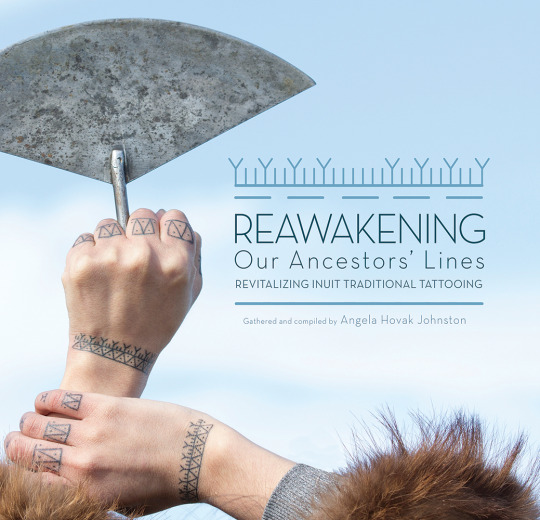


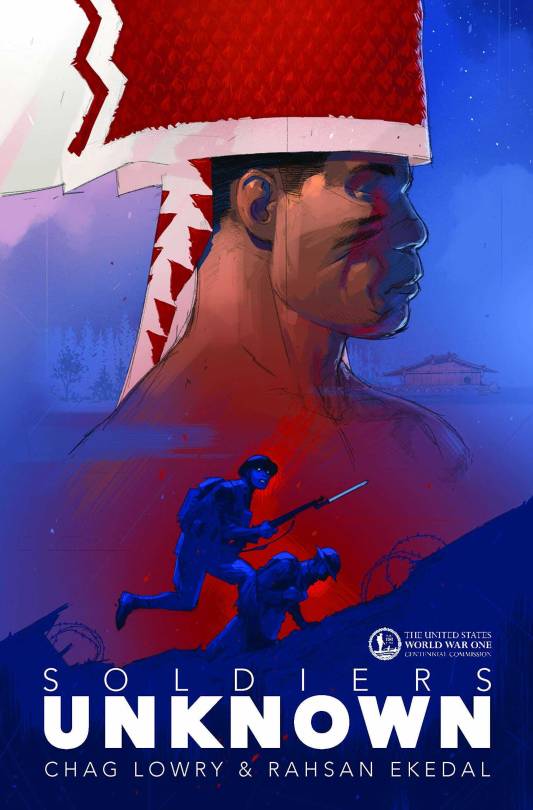


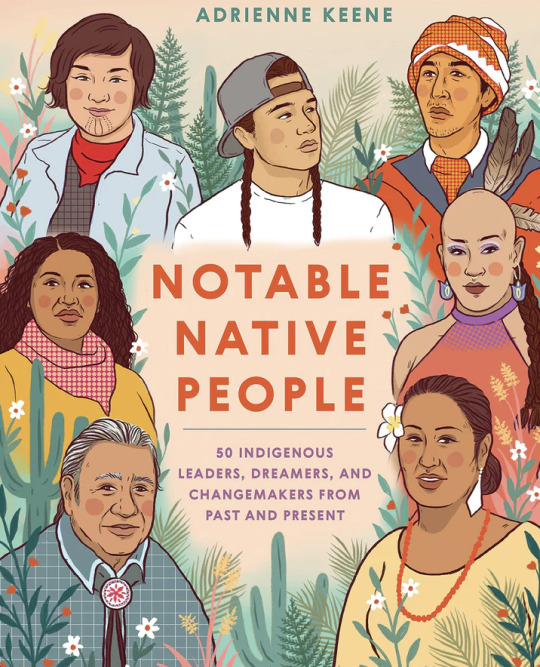


Reawakening Our Ancestor’s Lines and Other AIYLA Titles
When I was in the library the other day, a book cover caught my eye. Somehow I had missed out on this book that was released in 2017. I’m sure I saw the list when it was honored by The American Indian Library Association back in 2020, but I never got my hands on Reawakening Our Ancestors’ Lines: Revitalizing Inuit Traditional Tattooing until this week. It’s a gorgeous book that features Inuit women who are reviving the traditional art of tattooing. The author, Angela Hovak Johnston, learned how to tattoo herself and others and the book shares that journey with others.
For thousands of years, Inuit women practiced the traditional art of tattooing. Created with bone needles and caribou sinew soaked in seal oil or soot, these tattoos were an important tradition for many women, symbols stitched in their skin that connected them to their families and communities.But with the rise of missionaries and residential schools in the North, the tradition of tattooing was almost lost. In 2005, when Angela Hovak Johnston heard that the last Inuk woman tattooed in the traditional way had died, she set out to tattoo herself and learn how to tattoo others. What was at first a personal quest became a project to bring the art of traditional tattooing back to Inuit women across Nunavut, starting in the community of Kugluktuk. Collected in this beautiful book are moving photos and stories from more than two dozen women who participated in Johnston’s project. Together, these women are reawakening their ancestors’ lines and sharing this knowledge with future generations. [publisher summary]
This book is just one of the many that have won or been honored over the years. In case you’ve missed any of the titles, here are a few other YA books that have made the American Indian Youth Literature Award lists:
Apple Skin to the Core by Eric Gansworth (Onandoga)
The term “Apple” is a slur in Native communities across the country. It’s for someone supposedly “red on the outside, white on the inside.” Eric Gansworth is telling his story in Apple (Skin to the Core). The story of his family, of Onondaga among Tuscaroras, of Native folks everywhere. From the horrible legacy of the government boarding schools, to a boy watching his siblings leave and return and leave again, to a young man fighting to be an artist who balances multiple worlds. Eric shatters that slur and reclaims it in verse and prose and imagery that truly lives up to the word heartbreaking.
Firekeeper’s Daughter by Angeline Boulley (Sault Ste. Marie Tribe of Chippewa Indians)
As a biracial, unenrolled tribal member and the product of a scandal, Daunis Fontaine has never quite fit in—both in her hometown and on the nearby Ojibwe reservation. When her family is struck by tragedy, Daunis puts her dreams on hold to care for her fragile mother. The only bright spot is meeting Jamie, the charming new recruit on her brother’s hockey team.
After Daunis witnesses a shocking murder that thrusts her into a criminal investigation, she agrees to go undercover. But the deceptions—and deaths—keep piling up and soon the threat strikes too close to home. How far will she go to protect her community if it means tearing apart the only world she’s ever known?
Soldiers Unknown by Chag Lowry (Yurok, Maidu and Achumawi)
The graphic novel Soldiers Unknown is a historically accurate World War One story told from the perspective of Native Yurok soldiers. The novel is based on extensive military research and on oral interviews of family members of Yurok WW1 veterans from throughout Humboldt and Del Norte counties. The author Chag Lowry is of Yurok, Maidu, and Achumawi ancestry, and the illustrator Rahsan Ekedal was raised in southern Humboldt. Soldiers Unknown takes place during the battle of the Meuse-Argonne in France in 1918, which is the largest battle in American Army history.
Marrow Thieves and the sequel Hunting by Stars by Cherie Dimaline (Metis Nation of Ontario)
Marrow Thieves – Just when you think you have nothing left to lose, they come for your dreams.
Humanity has nearly destroyed its world through global warming, but now an even greater evil lurks. The Indigenous people of North America are being hunted and harvested for their bone marrow, which carries the key to recovering something the rest of the population has lost: the ability to dream. In this dark world, Frenchie and his companions struggle to survive as they make their way up north to the old lands. For now, survival means staying hidden – but what they don”t know is that one of them holds the secret to defeating the marrow thieves.
Notable Native People: 50 Indigenous Leaders, Dreamers, and Changemakers from Past and Present by Adrienne Keene (Cherokee Nation) and illustrated by Ciara Sana (Chamoru)
An accessible and educational illustrated book profiling 50 notable American Indian, Alaska Native, and Native Hawaiian people, from NBA star Kyrie Irving of the Standing Rock Lakota to Wilma Mankiller, the first female principal chief of the Cherokee Nation.
Celebrate the lives, stories, and contributions of Indigenous artists, activists, scientists, athletes, and other changemakers in this beautifully illustrated collection. From luminaries of the past, like nineteenth-century sculptor Edmonia Lewis--the first Black and Native American female artist to achieve international fame--to contemporary figures like linguist jessie little doe baird, who revived the Wampanoag language, Notable Native People highlights the vital impact Indigenous dreamers and leaders have made on the world.
Elatsoe by Darcie Little Badger (Lipan Apache Tribe)
Elatsoe—Ellie for short—lives in an alternate contemporary America shaped by the ancestral magics and knowledge of its Indigenous and immigrant groups. She can raise the spirits of dead animals—most importantly, her ghost dog Kirby. When her beloved cousin dies, all signs point to a car crash, but his ghost tells her otherwise: He was murdered. Who killed him and how did he die? With the help of her family, her best friend Jay, and the memory great, great, great, great, great, great grandmother, Elatsoe, must track down the killer and unravel the mystery of this creepy town and it’s dark past. But will the nefarious townsfolk and a mysterious Doctor stop her before she gets started? A breathtaking debut novel featuring an asexual, Apache teen protagonist, Elatsoe combines mystery, horror, noir, ancestral knowledge, haunting illustrations, fantasy elements, and is one of the most-talked about debuts of the year.
An Indigenous Peoples’ History of the United States for Young People adapted by Debbie Reese (Nambé Owingeh) and Jean Mendoza from the adult book by Roxanne Dunbar-Ortiz
Spanning more than 400 years, this classic bottom-up history examines the legacy of Indigenous peoples' resistance, resilience, and steadfast fight against imperialism.
Going beyond the story of America as a country "discovered" by a few brave men in the "New World," Indigenous human rights advocate Roxanne Dunbar-Ortiz reveals the roles that settler colonialism and policies of American Indian genocide played in forming our national identity.
The original academic text is fully adapted by renowned curriculum experts Debbie Reese and Jean Mendoza, for middle-grade and young adult readers to include discussion topics, archival images, original maps, recommendations for further reading, and other materials to encourage students, teachers, and general readers to think critically about their own place in history.
Surviving the City written by Tasha Spillet (Nehiyaw-Trinidadian) and illustrated by Natasha Donovan (Métis Nation of British Columbia)
Tasha Spillett's graphic novel debut, Surviving the City, is a story about womanhood, friendship, colonialism, and the anguish of a missing loved one. Miikwan and Dez are best friends. Miikwan is Anishinaabe; Dez is Inninew. Together, the teens navigate the challenges of growing up in an urban landscape - they're so close, they even completed their Berry Fast together. However, when Dez's grandmother becomes too sick, Dez is told she can't stay with her anymore. With the threat of a group home looming, Dez can't bring herself to go home and disappears. Miikwan is devastated, and the wound of her missing mother resurfaces. Will Dez's community find her before it's too late? Will Miikwan be able to cope if they don't?
To learn about even more books that have received this award, be sure to check out the AILA page.
159 notes
·
View notes
Text
Brainwaves Bios: Doctor Egon Spengler (1984)
The Brain of The Ghostbusters Doctor Egon Spengler, PhD

The brains of the Ghostbusters. He designed all the team's equipment and normally comes up with the plan to trap the ghosts. Overly analytical, Egon comes off as colder and more distant than he actually is.
"I collect spores, molds, and fungus."
Name
Full Legal Name: Egon Malachi Spengler
First Name: Egon
Meaning: From the Old German name 'Egino' derived from the element 'Agin' meaning 'Edge, Blade'
Pronunciation: EH-gawn
Origin: German
Middle Name: Malachi
Meaning: From the Hebrew name 'Mal'akhi' meaning 'My messenger' or 'My angel'
Pronunciation: MAL-a-kie
Origin: Hebrew, English, Biblical, Biblical Latin
Surname: Spengler
Meaning: Occupational surname literally meaning 'Metal worker' or 'Tin knocker'
Pronunciation: SPENG-ler
Origin: German
Titles: Doctor, Professor, Mr
Nicknames: Egie, Spengs
Characteristics
Age: 40
Gender: Male. He/Him Pronouns
Race: Human
Nationality: American Citizen. Born in America
Ethnicity: White
Birth Date: November 21st 1944
Sexuality: Aromatic, Straight
Religion: Jewish
Native Language: English
Known Languages: English, Hebrew, Spanish, Chinese, Japanese, Russian, Portuguese, Latin, Greek, Egyptian, Arabic
Relationship Status: Single
Astrological Sign: Scorpio
Actor: Harold Ramis

Geographical Characteristics
Birthplace: Cleveland, Cuyahoga County, Ohio
Current Residence: North Moore Street, New York, New York
Appearance
Height: 6'5" / 195 cm
Weight: 175 lbs / 79 kg
Eye Colour: Brown
Hair Colour: Brown
Hair Dye: None
Body Hair: Hairy
Facial Hair: Clean Shaven
Tattoos: (As of Jan 1984) None
Piercings: None
Scars: None
Health and Fitness
Allergies: None
Alcoholic, Smoker, Drug User: Clean
Illnesses/Disorders: None Diagnosed (Possibly Autistic)
Medications: None
Any Specific Diet: None
Relationships
Affiliated Groups: Ghostbusters (Founding Member)
Friends: Peter Venkman, Raymond Stantz, Winston Zeddemore, Janine Melnitz, Louis Tully (Sort-Of), Dana Barrett
Significant Other: None
Previous Partners: None of Note
Parents: Edmund Spengler (70, Father), Esther Spengler (73,Mother, Née Schneider)
Parents-In-Law: None
Siblings: Elon Spengler (40, Twin Brother)
Siblings-In-Law: Eliana Spengler (37, Elon's Wife, Née Salomon)
Nieces & Nephews: Edward Spengler (4, Nephew)
Children: None
Extras
Level of Education: Anthropology PhD, Astronomy PhD, Chemistry PhD, Engineering PhD, History PhD, Metallurgy PhD, Mycology PhD, Parapsychology PhD, Philosophy PhD, Physics PhD, Psychology PhD
Occupation: Ghostbuster
Employer: Ghostbusters
Expertise:
Genius with an Eidetic Memory
Polyglot
Physicist
Mycologist
Chemist
Historian
Parapsychologist
Anthropologist
Astronomer
Engineer
Metallurgist
Faults:
Sweet-Tooth
Perceived Lack of Emotions
Doesn't Have a Driver's License
Backstory: Egon Spengler grew up with no toys because his parents didn't believe in them. For unknown reasons, he had part of a Slinky but he straightened it. On October 29, 1969, Egon graduated from Columbia University with a degree in Psychology in the faculty of Psychobiology. On May 10, 1972, Egon graduated from New York University with a degree in Parapsychology. On June 26, 1980, Egon graduated from the Massachusetts Institute of Technology with a degree of philosophy in Nuclear Engineering. Egon was very interested in paranormal phenomenon, and worked with Raymond Stantz and Peter Venkman at Columbia University's Paranormal Studies Laboratory in Weaver Hall. He and Raymond studied paranormal literature in their spare time and were interested in theories of reincarnation. Egon developed the P.K.E. Meter to detect paranormal entities and phenomena with. Egon and Raymond were usually the first to interview case subjects, even people Peter called 'Schizos' no matter how far-fetched their stories were.
14 notes
·
View notes
Photo
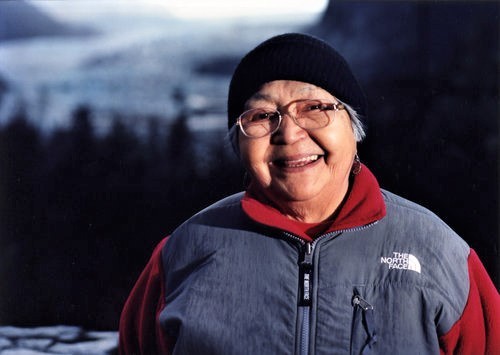
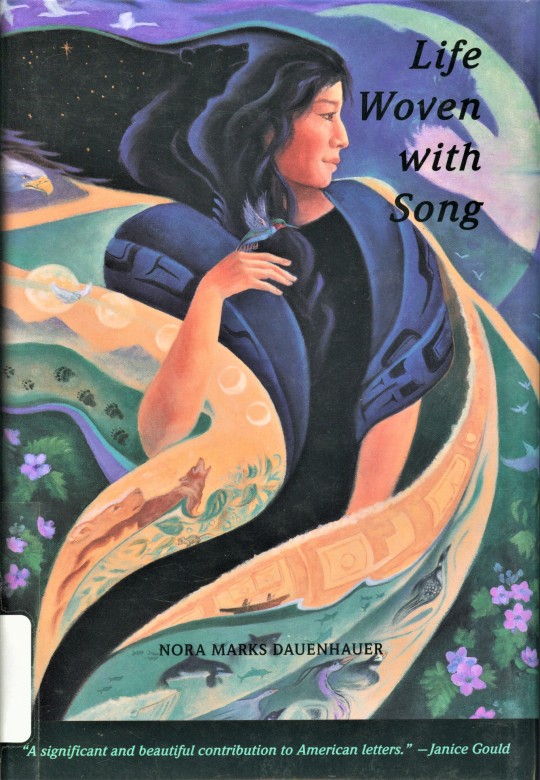



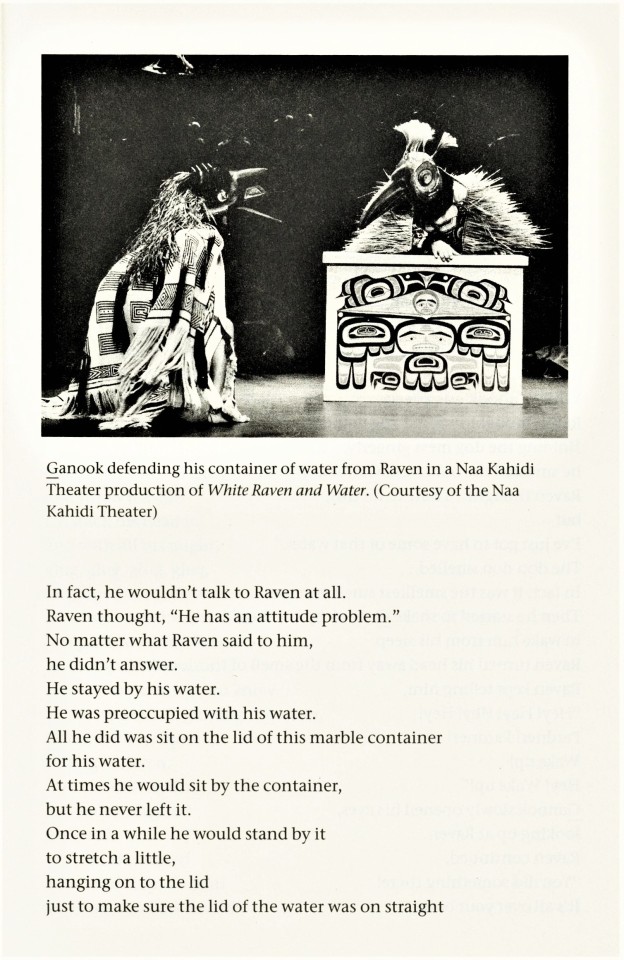

Native American/First Nations Woman Writer of the Week
NORA MARKS DAUENHAUER
Continuing on our trek through what remains of March, I offer you another Indigenous woman writer, Nora Marks Keixwnéi Dauenhauer (1927-2017), a Tlingit writer from Juneau, Alaska. Born in Juneau, Dauenhauer grew up there as well as in Hoonah, Alaska with a father who was a fisherman and carver, and a mother who was a beader. Dauenhauer lived at times with her parents on a fishing boat and in seasonal camps. Being a member of the Tlingit tribe, her first language was Łingít, and she did not learn English until she was eight.
Following her mother in the Tlingit matrilineal system, she was a member of the Raven moiety of the Tlingit nation, of the Yakutat Lukaax̱.ádi (Sockeye Salmon) clan, of the Shaka Hít or Canoe Prow House, from Alsek River. She was chosen as clan co-leader of Lukaax̱.ádi (Sockeye Salmon) in 1986 and as trustee of the Raven House and other clan property. She was then given the title Naa Tláa (Clan Mother) in 2010, becoming the ceremonial leader of the clan.
Dauenhauer earned a BA in anthropology from Alaska Methodist University in Anchorage. In the early 1970s, she married poet and Tlingit scholar Richard Dauenhauer and together they made significant contributions to preserve the Tlingit oral traditions in their Classics of Tlingit Oral Literature book series. Nora Dauenhauer became a Tlingit language researcher for the Native Language Center at the University of Alaska, Fairbanks from 1972-1973, and then became the principal researcher in language and cultural studies at the Sealaska Heritage Foundation in Juneau from 1983-1997.
On the subject of preserving the Tlingit oral tradition and its importance, Dauenhaur said:
People are now beginning to take action for language and cultural survival, and my work is to help provide inspiration and tools for this through my writing.
Dauenhauer had several accomplishments, including being named the 1980 Humanist of the Year by the Alaska Humanities Forum. Together, the Dauenhauers were awarded the Alaska Governor’s Award for the Arts, two American Book Awards, and a Before Columbus Foundation American Book Award. In 2005, Nora Dauenhauer was the recipient of the Community Spirit Award from the First People’s Fund.
As a poet, Nora Dauenhauer published two collections, one of which we hold in Special Collections, Life Woven With Song, published by the University of Arizona Press in 2000 (the other is The Droning Shaman, Black Current Press, 1989). This book recreates the oral tradition of the Tlingit people through written language in a variety of literary forms, and records memories of Dauenhauer’s heritage from old relatives and Tlingit elders, to trolling for salmon and preparing food in the dryfish camps and making a living by working in canneries.
Author Photo is by Hulleah Tsinhnahjinnie
See other writers we have featured in Native American/First Nations Woman Writer of the Week.
View other posts from our Native American Literature Collection.
-- Elizabeth V., Special Collections Undergraduate Writing Intern
#Native American/First Nations Woman Writer of the Week#women's history month#Native Americans#Native American writers#Native American women writers#Nora Marks Dauenhauer#Richard Dauenhauer#Tlingit#Life Woven With Song#University of Arizona Press#Alaskan writers#poets#poetry#Elizabeth V.#Native American Literature Collection
136 notes
·
View notes
Note
Here’s that Twitter thread translated + quotes. No pics bc lazy (: Hope this helps!
Re-reading the lyrics of "Daylight," and especially the verse that mentions the "Bluebird," I wondered several times what Harry's sources of inspiration might have been and why he chose this particular bird.
Aside from Louis
The Bluebird (Sialia, in Italian) over the years has also taken on mythological connotations and is often found in seafaring literature. It would represent eternal happiness as well as springtime.
In the Native American Cochiti tribe, the Sun's firstborn son is named Bluebird. In the short story "The Sun's Children," featured in Ruth Benedict's Tales of the Cochiti Indians (1932), the Sun's male child was named Bluebird (Culutiwa). (Sun -> Bluebird -> Louis)
In Navajo tradition the Bluebird is associated with the rising Sun. The Bluebird Song is sung to remind tribal members to rise at dawn to give thanks to the rising Sun. "Bluebird said to me: Get up, my grandchild. It is dawn; it said to me."
The bluebird, understood as a representation of the concept of freedom, which coincides with a form of "resurrection," is also found in two of the authors whom Harry has repeatedly acknowledged to be a source of inspiration for him: Paul McCartney and David Bowie.
“Oh I'll be free, just like that bluebird. Oh I'll be free. Ain't that just like me?" sings Bowie in "Lazarus." A kind of testament, where he seems to want to tell us: just as I am dying, I am ready to be reborn and to feel free at last, whatever form I will take.
In McCartney, the Bluebird (a song written with his wife Linda during a vacation in Jamaica) becomes a metaphor for the transcendent power of love and the liberation of the human spirit from a form of physical and mental slavery. The Bluebird itself becomes a symbol of Love, understood as the only source of Freedom.
“Late at night when the wind is still I'll come flying through your door, and you'll know what love is for; I'm a bluebird.”
Turning to literature, we know that Harry also loves Charles Bukowski. Several times he has been seen reading his poetry, and his writing has also been influenced by the poet in the past. No wonder, then, that Bukowski wrote a poem entitled "Bluebird."
“There's a bluebird in my heart that wants to get out but I'm too tough on him”
First published in 1992 in the collection "Last Night of the Earth Poems," Bukowski tells of the malaise inherent in every person, a pain that each of us feels, latent, a kind of background noise of our existence. Again, that longed-for sense of freedom.
The Bluebird is also quoted by Oscar Wilde in "The Decay of Lying (1889)." A Bluebird singing about beautiful and impossible things that are not but should be. Yeah...
“Champing his gilded oats, the hippogriff will stand in our stalls; and over our heads will float the Blue Bird singing of beautiful and impossible things, of things that are lovely and that never happen, of things that are not and that should be.”
In "May-Day," by Ralph Waldo Emerson, we find not only the bluebird but also daffodils. I wonder where I have seen them before
“When I bought my farm, I did not know what a bargain I had in the bluebirds, daffodils and thrushes; as little did I know what sublime mornings and sunsets I was buying.”
"Gay as a daffodil" = "Gay as a bluebird" Finally, I couldn't help but look up the meaning of Bluebird in Urban Dictionary (it's all Harry's fault and his cryptic slang). I leave the considerations to you. *definition posted 2017
(Don’t mind me lurking on your page I sent in some stuff last night so I’m 👀)
You are brilliant. Thank you so much for taking the time to translate all of that!! That’s really a beautiful thread and now I love that song even more. 😭😭😭😭
#daylight#hs3 spoilers#daylight song analysis#David Bowie#paul mccartney#charles bukowski#ralph waldo emerson#bluebird
231 notes
·
View notes
Text
Today is International Translation Day
The United Nations General Assembly passed a resolution to observe September 30 as International Translation Day because it happens to be the feast day of the translator of the Bible, St. Jerome, who died in 420 AD.
Reading translated literature doesn't just mean reading books that have been translated into our native language. It means gaining access to the stories, culture, traditions, lands, philosophies, politics, and methods of storytelling from far-flung nations.
It allows us to see mountains and rivers far from our own; to meet people with different backgrounds and experiences; to understand the arts and histories of places we’ve never seen.
It us feel connected to the the world as one people with the same worries and concerns, and the same joys and resiliance. In a world facing global crisis that will require a united humanity to resolve, translated works enables the empathy that we will need to come together.
I am celelebrating International Translation Day by sharing a few of my favorite translated books. Feel free to share yours.
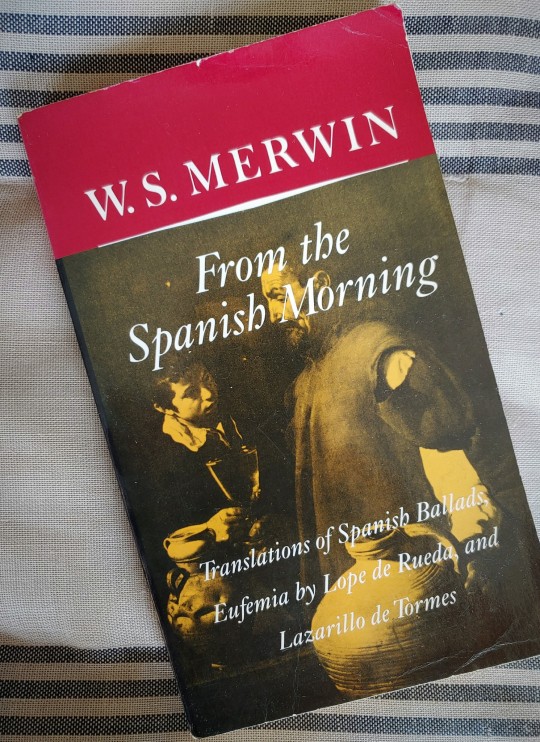
W S Merwin is an American poet laureate but I have always like him more as a translator. As a poet himself he has a unique authority that allows him to cut to the meat of a poem by discarding anything that gets in the way of the authors intent. From a Spanish Morning is wonderful collection of 15th to 17th century Spanish poetry and prose.
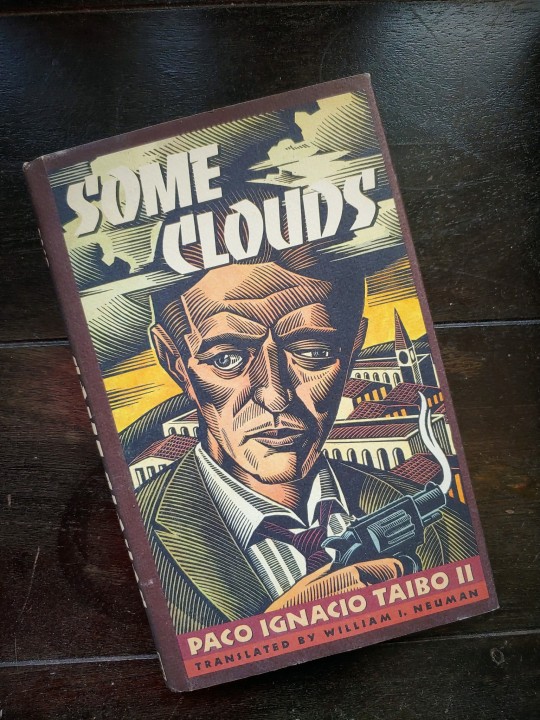
Paco Ignacio Taibo II is a Mexican writer whose private eye Héctor Belascoáran Shayne is one of my favorite gumshoes and the subject of a Spanish language tv show on Netflix. Some Clouds,translated with great pace and humor by William Neuman, is my favorite book in his series. Its great Mexican Noir with a Cohen Brothers vibe.
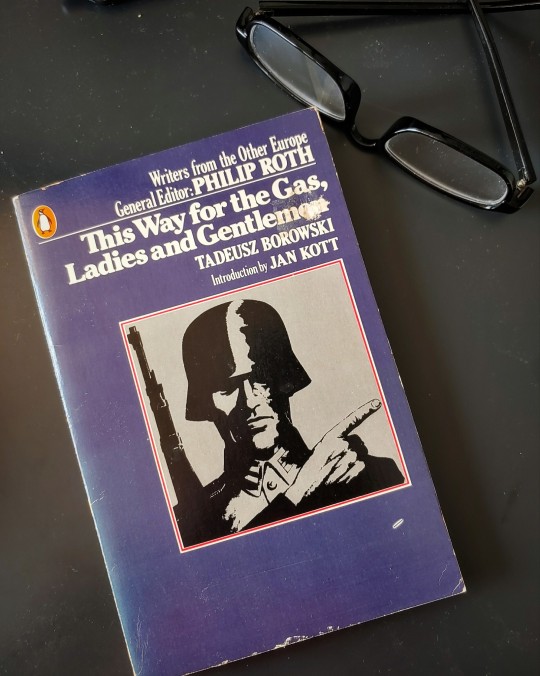
Philip Roth's Writers From Other Europe series from Penguin was a great publishing project in the 70s. The series introduced me to Milan Kundera and Geza Csath, writers that are in my wheel house and I would have likely found anyway but what was so innovative about this was that by presenting the books as a series rather than individual authors I also read titles I likely would never have exposed myself to on my own. I am not a WWII fan and generally gravitate other topics but picked up Tadeuz Borowski's This Way to the Gas, Ladies and Gentlemen because it was the next book in Roth's series and I had loved everything so far. Wow. In the words of translator Barbara Vedder, "Despite the deceptive simplicity of his style and of his documentary technique, his writing carries a burden of meaning that far transcends the mearly actual."
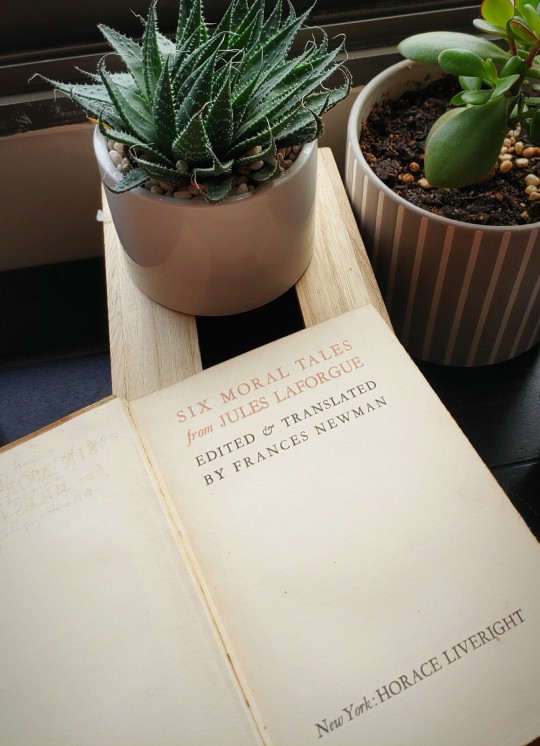
Jules Laforgue was a French-Uruguayan symbolist poet and writer. The New York Times described Laforgue's Moral Tales as thus, "Mallarme defined the author of these ‘Moral Tales’ as the Voltaire of Symbolism - a demystifier of the cultural bric-a-brac of the bourgeoisie, a dandyish demolition expert specializing in disenchantment. According to Ezra Pound (who translated one of these stories in 1918), Laforgue had delivered the coup de grace to the facile exoticism (and eroticism) of the 19th-century historical novel; in clearing out the residual rubbish of romanticism, he had prepared the way for modernist prose."
This translator of this 1928 Liveright edition is no less interesting. Novelist in her own right, Frances Newman challenged the confining traditions of “southern womanhood” and fearlessly portrayed Atlanta’s privileged white society in the 1920s. A debutante-cum-librarian whose sophisticated, trenchant writing made her a sought-after Atlanta columnist and East Coast critic, Newman is best remembered for her avant-garde stories of women's inner lives. “If you grow up hearing of mistress’s sons who set dogs on a little girl three years old to see her run, who beat the slaves, and who didn’t tell them they were free, you can’t admire the antebellum South completely.”
Newman traveled to France to research the 19th-century writer Jules Laforgue for her next book, a translation of his Moralités légendaires. She developed a painful eye affliction that European doctors were unable to diagnose or successfully treat, and she returned to the United States for medical attention. Back in Atlanta, unable to read, Newman completed her translations by dictation, but her malady continued to afflict her. It would frustrate doctors in Atlanta, Philadelphia and, ultimately, New York City, where she visited a neurologist in October and signed her contract for Six Moral Tales from Jules Laforgue. On October 19, after she failed to meet a friend at Carnegie Hall, Newman was found unconscious in her hotel room. Hospitalized, she never regained consciousness and died three days later. The tabloids claimed the "spinster" had killed herself with a drug overdose. Officially the cause of her death was recorded as pneumonia following a cerebral hemorrhage. Newman's Laforgue translation was published soon afterward.
#international translation day#translators#booklovers#librarians#literacy#world literature#book publishing
10 notes
·
View notes
Photo
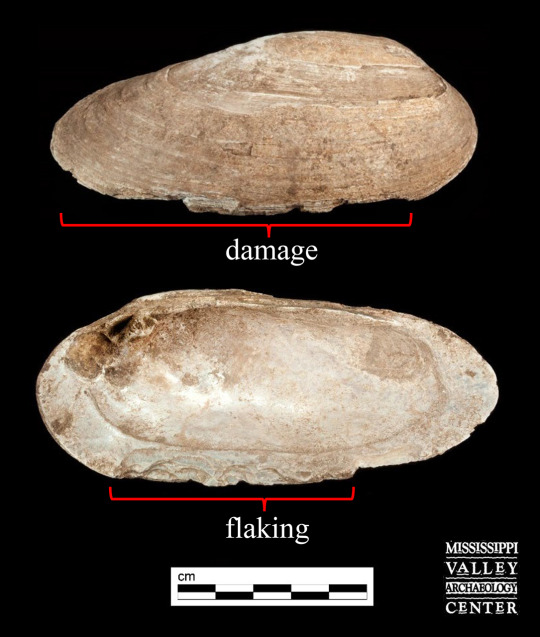
People in the past fashioned tools out of not just a variety of animal bones, but mussel shell as well. This complete right valve (shell) of a black sandshell (Ligumia recta) mussel from 2012 MVAC excavations beneath STH 35 in Onalaska, Wisconsin, is just one example. It was used for scooping, scraping, or digging, as shown by wear along the long edge opposite the hinge, where the left and right halves of the mussel shell would join. Damage is visible on the outside of the shell (top), as is flaking on the inside of the shell (bottom). This edge of the shell, given it came from a black sandshell, likely would have been razor-sharp initially.
Though not a common artifact for La Crosse area Oneota sites, similar modified and edge-damaged shells at Oneota sites along the Des Moines River in Iowa and to the west have been shown to have been used for shelling the kernels from ears of parboiled green corn. An extensive literature review and ethnographic studies by the late Dr. David Gradwohl found that a number of Native American tribes employed mussel shells in a rather elaborate process of preparing corn for immediate consumption or storage. Interestingly, at Iowa Oneota sites, the black sandshell was the preferred species used for the proposed corn shellers (see Gradwohl 1982:135–156). The black sandshell is not uncommon in large and medium rivers of the Midwest, including the Mississippi.
Gradwohl, David Mayer
1982 Shelling Corn in the Prairie-Plains: Archaeological Evidence and Ethnographic Parallels beyond the Pun. In Plains Indian Studies: A Collection of Essays in Honor of John C. Ewers and Waldo R. Wedel, edited by Douglas H. Ubelaker and Herman J. Viola, pp. 135–156. Smithsonian Contributions to Anthropology No. 30. Smithsonian Institution, Washington DC.
38 notes
·
View notes
Note
this is my essay on the rapture if you were ever interested in reading <33 one of my top 4 movies of all time!!
first off mikaela, i just want to say this to you: you are delightfully big brained, and its a treasure to be able to walk through a movie this brilliant with you. you have a fantastic knack for analysis (one that i envy and i hope all of your english teachers complimented you on), with an eloquence that makes you an easy voice to follow.
secondly, i just want to say: you really captured what drew me to this movie, and described it beautifully along the way. this paragraph especially:
Where The Rapture thrives is in its dichotomous approach to religion as both maniacal desperation and delicate salve, as something that harms and something that you just can’t help but cling to. When talk of being called to Heaven began, it was in visions of rivers and pearls. At its culmination, it’s in inability to cope with grief, about wanting to see a loved one that’s been lost. By the time Sharon stands in a tent with her dirty and starving baby girl, jumping at any sound, waiting to be called to God, you start to feel she might’ve been better off taking her chances with the heroin.
i'm an english major, but on my way to getting that degree i've taken a fair share of religious classes too. it fascinates to me learn about religion as someone who was once really good friends with it, and now feels sorta at odds with it at all times. one of the classes i most enjoyed taking posited the idea that religion, along with all things, is a complex organization, neither completely good or completely bad as a whole. we had an entire unit on the benefits of organized religion -- how it offered a sense family, and a sense belonging to immigrants when they came to america; how it played into the civil rights movement; how it put women in novel positions of power (allowing them to organize events before they were allowed their own bank accounts). other classes i took, like latin american history and native american literature, showed the ways that religion allows for preservation of native cultures, even as they are being threatened. catholicism in mexico is saint-heavy and the religious holidays align with indigenous ones, because the indigenous people refused to commit to a religion that resembled nothing they understood to be true. the catholic priests had to adapt and now mexican catholicism is a blend of what was and what came to be. in america, there's so many different strands of catholicism, each a little different, because people who came from ireland and people who came from italy both needed something different, something wholly familiar.
what i'm trying to get at, and what you probably already know is: religion can be great. it can be visions of rivers and pearls - a delicate salve, as you put it - but it can also be horrid, desperate, needy. the rapture does a good job at representing this, and its probably why i like it so much. i haven't honestly sat down and collected all my thoughts on this film before today. i watched it late one night and have continued to be haunted by it, but until reading your essay i never really pinpointed why it has followed me like it has. i think the paragraph before your concluding one offers me up an explanation:
In the end, having given up her daughter out of hope in God, it’s that very loss that breaks the faith that Sharon has filled her emptiness with. Tolkin could have grounded his theme in Sharon’s theological accuracy, and told a story about a woman who was resolute in her convictions, and rewarded with being correct. Instead, he leaves the audience with something much more resonant, and cruel: what if you were right, and it didn’t matter?
what if you were right, and it didn't matter? i think this is a fear that follows both those who follow the church of god and those who subscribe to nothing at all, and maybe that's why its such a terrible gut punch. what happens when do everything you were meant to do, and you come to the other side and find it all doesn't matter? its a terrible, daunting notion that has been stuck in my throat until today, when i read this.
thank you so much for sitting down and writing this essay, and also for taking the time to send it to me. it was a delight to read and i'm so happy to find someone else who enjoys this movie as much as a i do.
7 notes
·
View notes